Todd Klein's Blog, page 44
May 8, 2023
Where I’ll be next Saturday…
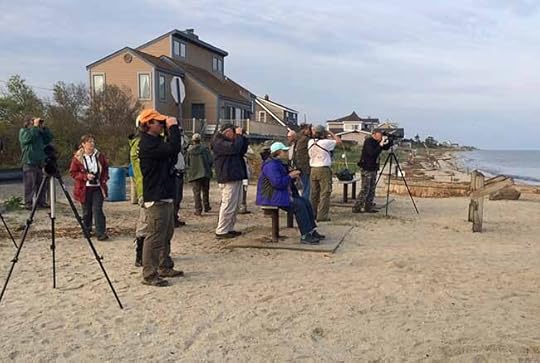 From the 2018 Cape May Century Run, World Series of Birding.
From the 2018 Cape May Century Run, World Series of Birding.Since 1984, the New Jersey Audubon Society has used their World Series of Birding as a fundraiser. My first one was 1988, and I did it nearly every year from then until 2018. In 2019 I had to cancel due to a death in the family, and then Covid kept me out of it. I’m returning to the Cape May Century Run Team this year, and looking forward to it. Each team tallies as many species as they can see or hear in a specific geographic area of New Jersey. Some teams do the whole state, ours does only Cape May County. This year it happens next Saturday, May 13th. I will be out birding with the team from 5 AM to 9 PM at least. It’s a long day, but a fun challenge. In the past I have asked for donations to support my team and help NJ birds and NJ Audubon through Facebook and my blog. I’m not doing as much of that this year, but I do have a personal pledge page if anyone would like to contribute to our effort, and I would be most grateful if you did!
The post Where I’ll be next Saturday… appeared first on Todd's Blog.
May 5, 2023
Incoming: DEAD BOY DETECTIVES new printing
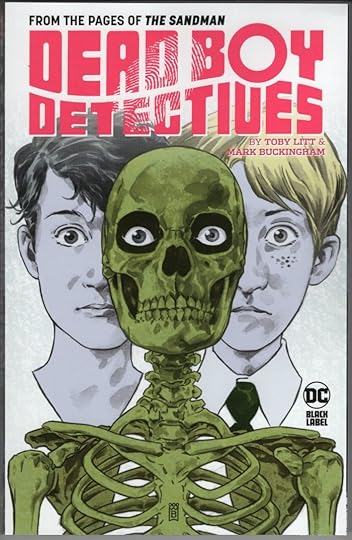
 Images © DC Comics
Images © DC ComicsA new printing of this 2014 series has arrived, no doubt prompted by the upcoming TV series which has now been moved to Netflix. I don’t know how the writers strike might affect that. The series was fun to letter, I always enjoy working with Mark Buckingham. The writing by Toby Litt was also good. The retail price is $29.99, and it’s due out in June. Check with your comics retailer, or there’s an Amazon link below.
Dead Boy Detectives by Toby Litt and Mark Buckingham
The post Incoming: DEAD BOY DETECTIVES new printing appeared first on Todd's Blog.
May 4, 2023
Rereading: TIME AND THE GODS by Lord Dunsany
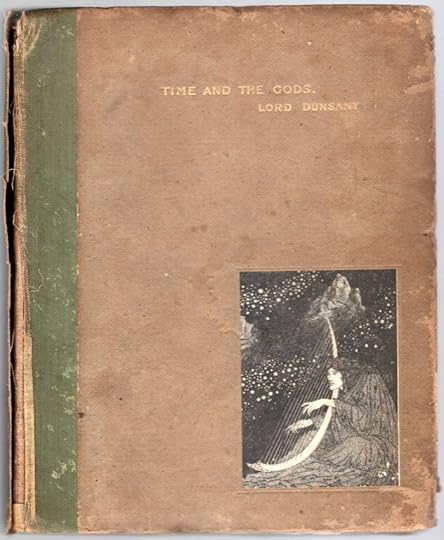 My worn and stained first edition.
My worn and stained first edition.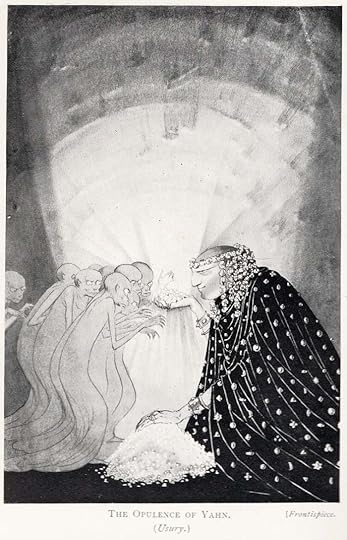 First tipped in plate by Sidney H. Sime.
First tipped in plate by Sidney H. Sime.Dunsany’s first book of short stories, “The Gods of Pegana,” did well, and this was his second, first published in 1906. Here, the gods generally step back a bit in favor of their servant, Time, who appears in several stories, as well as prophets, kings, and other men. The author continues to experiment with story lengths and types, with the final story in this book being quite long. He’s also growing as a writer, finding more interesting plots and structures, and imbuing his tales with creative imagery and sly humor, as in the story of a poor lame shepherd who is mistaken for a god and finds himself with a new life of immense luxury. One of the strongest images is in a tale of a king who decides to find and defeat Time. He and his army do track down the elusive creature in his castle on a high hill, and the king leads a charge, but Time hurls years at them until they are too old to climb the hill. I enjoyed rereading these stories. The illustrations by Sidney Sime are as impressive as in the first book, but perhaps to save money they’re photographically reproduced with a dot screen rather than the photoengraving process used for “The Gods of Pegana.” Details are therefore lost, but the plates are still appealing and help evoke a sense of wonder. Recommended, and easy to find now as an e-book, though I don’t know about the illustrations.
Time and the Gods by Lord Dunsany
The post Rereading: TIME AND THE GODS by Lord Dunsany appeared first on Todd's Blog.
May 2, 2023
And Then I Read: THE WAY HOME by Peter S. Beagle
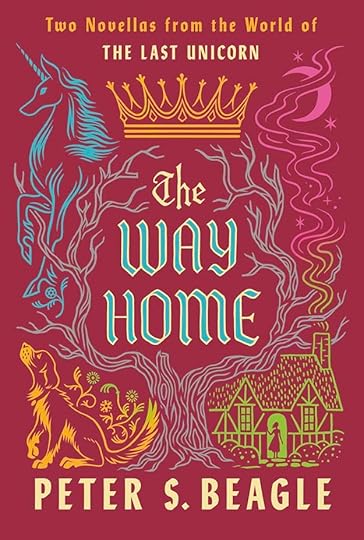
I wasn’t sure about buying this, as I already had the first story, “Two Hearts,” but bought and read it anyway. These stories are connected to one of Beagles best and earliest books, “The Last Unicorn,” and “Two Hearts” is one of my favorite stories by him. A small, remote village is being terrorized by a Griffin, who is picking off the livestock, and then the children one by one. Delegations to the King have brought back champions who vowed to kill the Griffin, but none survived those encounters. When a young girl, Sooz, loses her best friend to the beast, she decides to go to the King herself to insist he come and help. On her way, she meets and travels with two characters from “The Last Unicorn,” Schmendrick the Magician and Molly Grue, now both quite old, who are also going to see their quite old friend the King. Sooz reminds the King of his duty, and he agrees to take on the Griffin himself. When they return to Sooz’s village for that, a heartbreaking but satisfying conclusion to several stories emerges. Sooz is a wonderful character, and her narration brings the story to life brilliantly.
The second story, “Sooz,” is much longer, with twelve chapters. Sooz is now seventeen, and learns some painful things about her own origins and family. Her parents had a daughter, Jenia, before she was born who was stolen by fairies. Sooz’s father has never gotten over the loss. And Sooz herself is not really their daughter…she was found as an infant on their doorstep. The girl’s life has been turned upside down by this knowledge. What is she, really? Is she a fairy child left in exchange for the stolen one? Then Sooz sees a beautiful girl in the woods she feels certain is her lost sister, and her father confirms it. Sooz decides to enter fairyland and track down the stolen girl to find out the truth. Along the way she’s treated brutally by strange men, and makes a new friend of Dakhoun, a strange woman who seems to be made of living stone, and those two wander through weird lands and meet the mockery of the fairies as they try to find the lost child and the truth.
I didn’t like this story as much as the first one. It rambles, and seems to change directions and ambitions several times. I never felt convinced by the lost child’s actions, and even those of Sooz were less believable here than in “Two Hearts.” Still, this is worth reading for Beagle fans, particularly if you haven’t read the shorter first story before. Recommended.
The Way Home by Peter S Beagle
The post And Then I Read: THE WAY HOME by Peter S. Beagle appeared first on Todd's Blog.
April 28, 2023
And Then I Read: LORDS AND LADIES by Terry Pratchett

This book is the 14th Discworld novel, and focuses on the three witches, Granny Weatherwax, Nanny Ogg and Magrat Garlick after they’ve returned home to mountainous Lancre from their adventures in “Witches Abroad.”
King Verence and Magrat had developed a shy, unspoken romantic relationship before the trip, and she’s stunned to find out that he’s made all the preparations for them to marry. Magrat has not been very successful as a witch, so maybe becoming Queen of the tiny country would be a better career, but as she explores that option, is not sure it’s the right one, and she’s annoyed about it all being arranged for her.
Granny and Nanny discover they have competition as witches from some young Lancre girls who’ve formed a new coven in their absence. The challenge seems unimportant until the older witches find out that the girls have been awakening old powers and unlocking an ancient sealed gateway at a local stone circle. That threatens everyone in Lancre when elves begin to cross over the barrier, and while elves seem charming and harmless in the old folk tales, in reality they are vicious, heartless, and cruel opponents who are a threat to everyone. Meanwhile, back in Ankh-Morpork, a delegation of wizards led by Archchancellor Ridcully have decided accept an invitation to attend the royal wedding. Ridcully has fond memories of Lancre, which he visited in his youth. He brings along the Librarian and another Wizard. Before long, these characters and more are thrown into the usual humorous chaos of Discworld with some surprising connections among them, and events that will change everything.
As always, a fun read, and recommended. If you order this on Amazon, be sure not to order the play version by mistake, as I did. I’m sure it’s a fine play, but not what I wanted.
Lords and Ladies by Terry Pratchett
The post And Then I Read: LORDS AND LADIES by Terry Pratchett appeared first on Todd's Blog.
April 25, 2023
ABE KANEGSON – WILL EISNER LETTERER
 From THE SPIRIT Sept 5, 1948, “The Story of Gerhard Schnobble,” this and all Spirit images © Will Eisner Studios, Inc., original art courtesy of Heritage Auctions.
From THE SPIRIT Sept 5, 1948, “The Story of Gerhard Schnobble,” this and all Spirit images © Will Eisner Studios, Inc., original art courtesy of Heritage Auctions.In 1936, Will Eisner, one of comics’ most innovative creators, began working in the new field, first partnering with Jerry Iger to form one of the earliest packagers of comics, providing material for publishers that didn’t have their own creators. The studio was a financial success, but in 1940 Will sold his interest in it to launch a new type of comics project. It was a sixteen-page supplement (later eight pages) inserted into Sunday newspapers known as the Spirit Section for its lead feature and character, Will Eisner’s The Spirit, a masked man who was legally dead and lived in a hidden lair in a graveyard, from which he fought crime. The Spirit had no super-powers, but was amazingly tenacious and able to take all kinds of physical abuse while pursuing criminals, helping his friends, and aiding the police. Each of his stories ran seven pages, and they formed a wonderful and influential body of work for many years. The series had several letterers, including Sam Rosen and Martin DeMuth, but in 1947, Will hired Abe Kanegson. In the example above, one of Eisner’s favorite stories, Kanegson has added a great deal to the page through his creative and energetic lettering, as he always did. In an interview with Cat Yronwode published in The Comics Journal nos. 46-47 (1979, Fantagraphics), Eisner said about Kanegson:
“He was the best letterer I ever had. He worked with me from 1947 to about 1950. I don’t know what happened to him after that, but I miss him sorely. He brought far more to The Spirit than many of the background people ever did — he was very responsive to ideas and he added a creative dimension to comics, which I always thought was important. He’s the only one who ever really understood. I had other letterers before he came in, but he helped me reach out. Sure, I had certain standards I wanted him to follow—for instance, I did Old English before he came in, but he would take that Old English and really do it — his skill was enormous — even more, he understood the function of lettering in comics. He regarded it as something important. Everybody before him regarded it as a chore.”
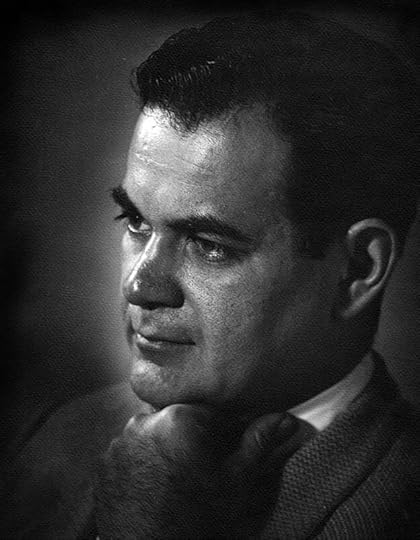 Abe Kanegson, 1950s, courtesy of his sister, Rita Perlin and Michael T. Gilbert, used with permission.
Abe Kanegson, 1950s, courtesy of his sister, Rita Perlin and Michael T. Gilbert, used with permission.Abraham Kanegson, birth-named Abram Chininson, was born either Sept 1 or 6, 1921, in Lubobin, Poland. Abe, his brother Morris, and his parents arrived in New York City’s Lower East Side in 1922. Abe’s father had a push-cart business selling ice, seltzer and other drinks from a wagon, later a truck. By 1930, the family was in The Bronx and had added Abe’s brother Louis and sister Rita. My information about Kanegson’s family comes from two sources, THIS article by Alex Jay, and a series of articles by Michael T. Gilbert that include family interviews from Alter Ego nos. 102-107 (2011-2012, TwoMorrows). This article wouldn’t be as complete without their help.
Abe was very intelligent. He attended James Monroe High School in The Bronx and finished in about two years. Abe’s siblings Rita and Lou said they didn’t think he had any formal art training, but he was always drawing with pen and ink or charcoal, and painting. He was already a talented artist as a teenager. Abe went to the City College of New York for a year at about age 15, and did cartooning for their magazine, Mercury, but he didn’t like college and dropped out. Abe had a severe stutter, but found that it went away if he sang, so he learned to play guitar and piano and sing folk songs, something he enjoyed all his life. He was also a fine dancer. After college, Abe worked at various jobs, including draftsman (he’d had no training in that, but was a quick study, and had no trouble landing the job). Abe’s sister Rita reported he helped build ships for the armed forces during World War Two. He also spent some time traveling around the country on the cheap, visiting friends.
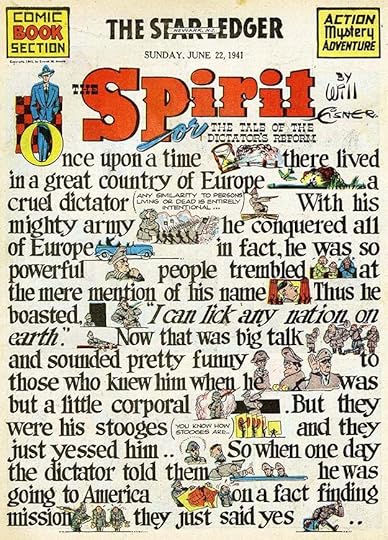 From THE SPIRIT, June 22, 1941, “The Tale of the Dictator’s Reform”
From THE SPIRIT, June 22, 1941, “The Tale of the Dictator’s Reform”Will Eisner was a fine letterer himself, as this early page shows, and most of his Spirit stories also feature his creative logos, usually different every time, often becoming architectural features in the art. Putting out a weekly newspaper insert was lots of work, though, and Eisner hired many assistants over the years. They carried on with the series while he was in the Army from 1942 to 1945. When he returned, Will brought even more innovative ideas to THE SPIRIT, and it reached its creative peak after the war.
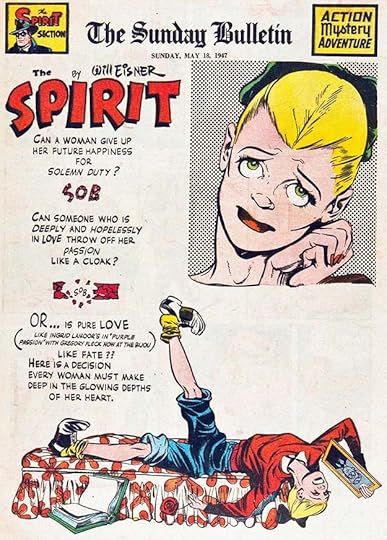 From THE SPIRIT, May 18 1947, “Saree Falls In Love”
From THE SPIRIT, May 18 1947, “Saree Falls In Love”Abe’s brother Lou was a comics fan growing up, but he said that Abe was not. It’s not known how he was able to letter comics so well right from the start, but again, he was a quick study. The story above seems to be the first one he lettered to my eye, and right away it establishes his talent for variety and creativity, though of course he was working from Will’s layouts and with his direction. Even so, the regular letters are well made, and rather than having the stiffness usually seen in a new letterer, already have appealing bounce.
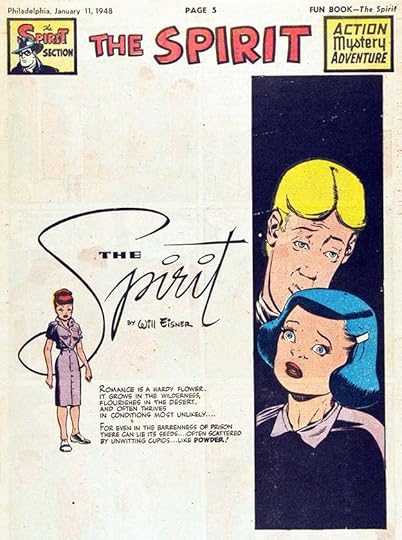 From THE SPIRIT, Jan 11, 1948, “The Fallen Sparrow”
From THE SPIRIT, Jan 11, 1948, “The Fallen Sparrow”This first page layout by Eisner is brilliantly simple and effective, but Kanegson’s graceful Spirit tltle and lettering makes it better.
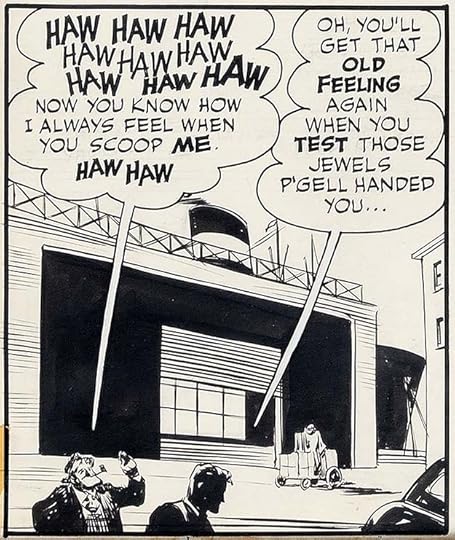 From THE SPIRIT, May 23, 1948, “Assignment: Paris”
From THE SPIRIT, May 23, 1948, “Assignment: Paris”Here’s a closer look at one panel of original art to show the Kanegson lettering in detail. The regular letters are made with a wedge-tipped pen, perhaps showing the influence of Frank Engli on the comic strip Terry and the Pirates, but by now a style being used by many letterers. Abe’s version is closer to Engli than some. The words made with a thicker pen point for emphasis all have squared corners on most strokes, something that took more time, and was probably done with a tiny pen point after the letters were drawn. This extra step was almost always added by Kanegson, and it makes the emphasis more effective. And all the lettering has bounce, making it more appealing to the eye. This is accomplished through slight up and down variations, and slightly curved rather than perfectly straight strokes. You can see why Will Eisner liked what Abe was doing, it complements his lively art perfectly.
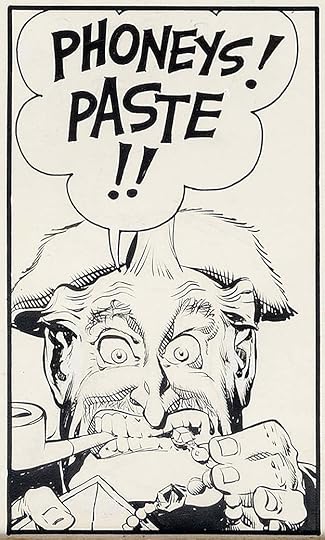 From THE SPIRIT, May 23, 1948, “Assignment: Paris“
From THE SPIRIT, May 23, 1948, “Assignment: Paris“The next panel on the same page has larger display letters that are even more impressive, and I also like Kanegson’s balloon shapes, which have symmetry and lots of air, and yet they’re clearly drawn freehand.
Cartoonist and author Jules Feiffer was assisting Will Eisner in his studio at the time Kanegson was there, and said this about him in his book Backing Into Forward: A Memoir (2010, Nan A. Talese, used with permission):
Abe was the left intellectual of the office, which also included Marilyn Mercer, Eisner’s business assistant and secretary, and Jerry Grandenetti, Eisner’s background man. I enjoyed an active and bantering relationship with my boss and the others in the studio, but I was closest to Abe, with whom I had developed a big brother – kid brother relationship. Abe played utility infielder at the office: he lettered, he inked backgrounds, he finished inking Eisner’s half-finished figures. He came from The Bronx, on East 172nd Street. He was five years older than I, big, burly, very hairy, a dark, wry, sardonic Russian Jew who lumbered as he walked. A strong presence but oddly, for all his impressiveness, without charisma. Maybe it was the stutter. Abe had a quick mind and wit and forceful opinions expressed in a rumbling, resonant baritone undermined by the worst stutter I had ever heard…I looked up to Abe. He was a Communist or fellow traveler (I never asked, he never told) to whom I awarded more credibility than to my sister Mimi because he didn’t beat up on me. Abe didn’t accuse me of being an “opportunist” or “indecisive,” nor was he trying to change me into the protégé Red that was Mimi’s ambition for me. My sense was that Abe was more interested in prodding/goading me into becoming a better and more serious cartoonist, the cartoonist that I liked to pretend I already was.
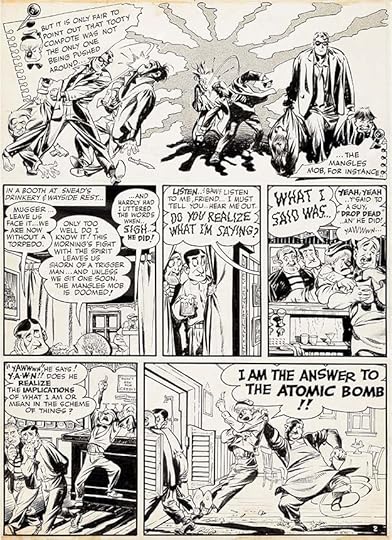 From THE SPIRIT, Oct 3 1948, “Tooty Compote”
From THE SPIRIT, Oct 3 1948, “Tooty Compote”Look at the wavy letters expressing the emotion of a character in shock on this page. I also like the two exclamation points on their own line in the last balloon, something many editors would frown on, but it works just fine. There’s so much life and variety in the lettering here, it’s equally as important to the storytelling as the art, a point I think Will Eisner would have agreed with.
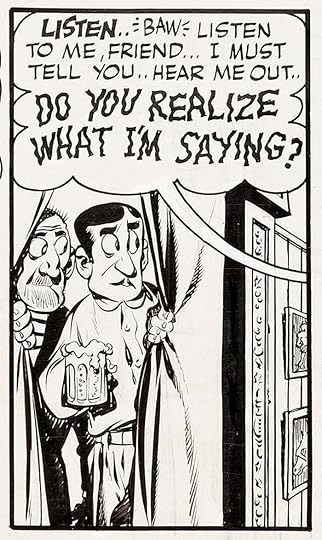 From THE SPIRIT, Oct 3 1948, “Tooty Compote”
From THE SPIRIT, Oct 3 1948, “Tooty Compote”In addition to the emphasized and wavy letters with pointed corners, Kanegson is using the style of breath marks around the word BAW that had gradually developed from parentheses over the preceding ten years or so, and continued to be used often by many letterers going forward. They have many names, and are unique symbols to comics, indicating extra breath being used on the word.
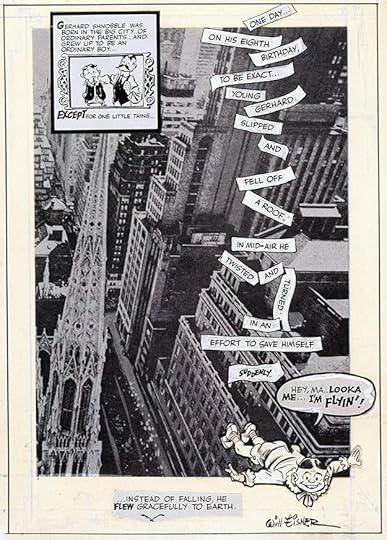 From THE SPIRIT Sept 5, 1948, “The Story of Gerhard Schnobble”
From THE SPIRIT Sept 5, 1948, “The Story of Gerhard Schnobble”Another page from Will Eisner’s favorite Spirit story, where the lettering and art (with photograph background) combines to carry the idea of flying particularly well. There’s white correction paint in some places, a little heavy-handed on the one balloon, but it all works great. The writing, art, and lettering each contribute a vital component that makes the whole greater than its parts.
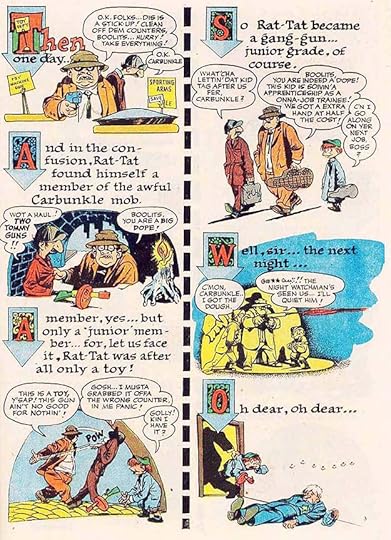 From THE SPIRIT. Sept 4 1949, “The Story of Rat-Tat the Toy Machine Gun”
From THE SPIRIT. Sept 4 1949, “The Story of Rat-Tat the Toy Machine Gun”There are so many fine examples from this period, it’s hard to pick just a few. Here Abe shows his mastery of upper and lower case letters made with a wedge-tipped pen in the style of a children’s story. The decorative capital letters are impressive, and I love the “Toy Dept” sign in the first one.
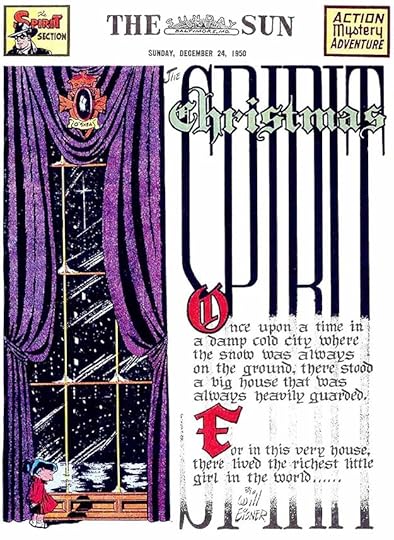 From THE SPIRIT, Dec 24 1950, “The Christmas Spirit of 1950”
From THE SPIRIT, Dec 24 1950, “The Christmas Spirit of 1950”Another fine design by Eisner which Kanegson enhances with excellent calligraphy, and impressive effects in the logo behind it. In a 2004 conversation with comics creator Dave Sim published in Following Cerebus no. 4 (Aardvark-Vanaheim), Will Eisner said of Kanegson:
“He was a tall fellow with frizzy red hair. He used to bring a guitar to work and play it and sing songs on his breaks. He had a strong social conscience, very much on the side of the downtrodden and on the side of labor. We got along fine. In fact, he used to fix my writing. I would rough in the captions and the dialogue, and he’d bring a page back and point to a caption and explain that there was something wrong with the grammar, or that the phrasing was redundant, and ask if I minded if he changed it. I’d say, ‘No, that’s fine. Go ahead.’ In fact, after a while I just told him to fix them. He didn’t have to bring it back for my approval.”
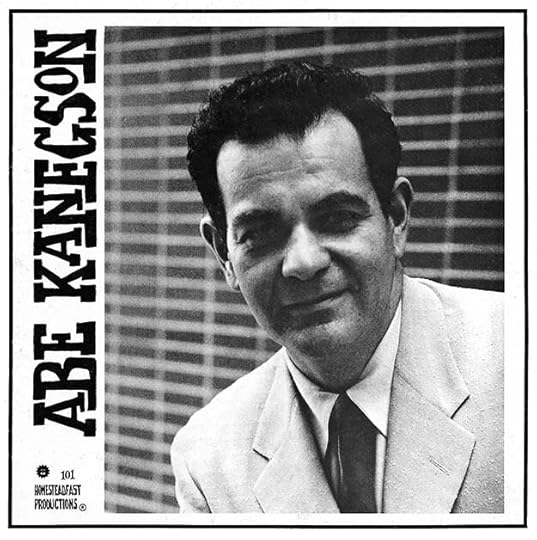 Front cover of a 1969 record album, Abe Kanegson, no. 101, Homesteadfast Productions
Front cover of a 1969 record album, Abe Kanegson, no. 101, Homesteadfast ProductionsIn 1950, Kanegson left the Eisner studio, possibly over a pay dispute, and cut all ties with comics. Eisner later regretted this, and for years he and Jules Feiffer searched for Kanegson. In 1952, issues of the Spirit Section ceased, and the character only appeared in new stories occasionally, while Will moved into commercial comics for clients like the U.S. Army. Jules Feiffer ran into Abe after he started working as a cartoonist for The Village Voice in 1956, and was rebuffed. He told me, “I was sorry that Abe, who I had learned so much from, discouraged contact. I think he was more comfortable with me as the Eisner office’s pip squeak and loudmouth. But seventy years later, he rings no less true, no less an original, and no less a key factor in my growth.” Will Eisner was not able to find out what happened to his best letterer before he himself died in 2005. It wasn’t until Michael T. Gilbert discovered the record album above in 2010 that that rest of Kanegson’s story came to light. After leaving comics, Abe took up a new career as a square dance caller and teacher, and a folk singer. Further research by Michael, his wife Janet, and Alex Jay found evidence of this from as early as 1951. More details are on Alex’s blog. Abe worked in various folk music summer camps and clubs around the country. He also taught square dancing. In January 1956, he opened the Village Square Dance School at 237 Bleecker Street, Manhattan, not far from the newspaper offices where Jules Feiffer worked as a cartoonist. In addition to teaching, Abe performed ethnic and folk songs and taught square dancing at festivals, church halls, hotels and on the radio. Abe met Elizabeth Celbman at his school and they were married in 1958. They had two sons, Andras and Ben. Later, Abe was a quick-sketch artist on a TV quiz show that only lasted one season. According to his sister Rita, Abe would come out in an artist’s smock, he never spoke, and contestants would try to guess what he was sketching. The name of the show is unknown.
 Kanegson photo and bio from the back of the record album
Kanegson photo and bio from the back of the record albumIn 1960, Abe was diagnosed with leukemia and began a battle with the disease that lasted five years, surviving longer than most at the time. He died on May 20, 1965 at the age of 44, a tragic loss to his family and friends. In a Michael T. Gilbert interview with Abe’s son, Ben Kanegson said about his father’s death:
It was just before my seventh birthday, so I was six. He had been sick for a long time. He traveled a lot. We didn’t address each other in the normal way because he knew he was going to die at the time of my conception. So he took more of the role of a friend, though he knew he was my father. He did act as my father also but a little more distant than with the other kids and in the last month I think, he was at home a lot and he was drawing.
Abe’s wife and friends put out the record album of his singing in 1969 as a memorial. The first track of the album can be heard HERE. The back of the album also says:
His friends often asked Abe when he was going to make a record; his answer was always, “I’m not ready yet.” He was waiting for the perfect moment, when his voice and style were fully developed, when his friends were gathered ’round, when the audience was in the right mood, when the surroundings were just so — a firelit room with perfect acoustics. While Abe waited, some of those friends, notably Norman Epstein, made informal tapes of his progress. It is from this “unauthorized legacy” that this record has been created. All money beyond costs goes into a fund for the education of Benjamin and Andras Kanegson, Abe’s two sons.
Abe Kanegson will long be remembered for his short but stellar career as a comics letterer, and for his other art and music accomplishments known to the world of his students, friends and family. Thanks again to Michael T. Gilbert and Alex Jay for research help and images.
The post ABE KANEGSON – WILL EISNER LETTERER appeared first on Todd's Blog.
April 20, 2023
And Then I Read: CONFABULATION by Dave Gibbons
 Published by Dark Horse, 2023
Published by Dark Horse, 2023Considering we live on different continents, I’ve spent a fair amount of time with Dave Gibbons. We got together on each of my five visits to England, and I’ve also been able to chat and catch up at numerous comics conventions. Ellen and I enjoyed one of his St. Albans hometown tours in 1987, and on our 1999 visit to London, we talked him into taking a tourist cruise on the Thames with us to the house that inspired Toad Hall in “Wind in the Willows.” Dave had us laughing often on that trip. Before all that, I first met Dave on the phone in 1982 when editor Ernie Colón had us work out a Green Lantern Corps story plot at that first meeting, and I loved the story that came from it. I’ve written a bit about that HERE. All this is to preface my reading of his new autobiographical book, which is really a series of anecdotes and stories about people and projects and interests that Dave wanted to share.
The format of the book is unusual, in that it’s alphabetical by topic rather than chronological. At times that worked fine, other times it meant flipping back and finding previous sections to connect events, but Dave is an excellent storyteller, both in person and in print, and I enjoyed reading the book as he chose to present it. One advantage for me is that I can hear Dave’s voice in the written text quite often, and that made it all the more fun. An audio book would be a good option, Dave! There were some stories here I’d heard, but plenty I hadn’t, and Dave’s slightly irreverent approach to everything, and his humor, made it all the more fun.
Highly recommended.
The post And Then I Read: CONFABULATION by Dave Gibbons appeared first on Todd's Blog.
April 18, 2023
Incoming: TOM STRONG COMPENDIUM

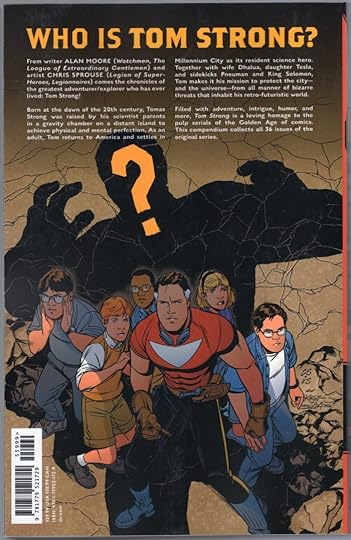 Images © DC Comics
Images © DC ComicsIn matching style to the recent TOP 10 COMPENDIUM, this one encompasses the entire 36-issue run of the series originally released in 1999 to 2006. While Alan Moore is the main writer and Chris Sprouse the main penciller, plenty of other top talents took part, including writers Leah Moore, Peter Hogan, Ed Brubaker, Michael Moorcock, Geoff Johns, Mark Schultz, Brian K. Vaughan, Joe Casey, and Steve Moore. Artists include main inkers Al Gordon and Karl Story plus Jerry Ordway, Shawn McManus, Duncan Fegredo, Cully Hamner, Arthur Adams, Dave Gibbons, Gary Frank, Cam Smith, Alan Weiss, Paul Chadwick, Gary Gianni, Russ Heath, Kyle Baker, Hilary Barta, Howard Chaykin, and Richard Friend. Of all the ABC series I lettered, I think this was the most fun to read, and I might read them again. I like the new front cover design combining my logo for issue #4 with Alex Ross’s art for issue #1. I would have appreciated a design credit somewhere inside for my covers, but one can’t have everything. Release date is May 16, check with your comics retailer, or use the Amazon link below. Original retail price is $59.99.
The post Incoming: TOM STRONG COMPENDIUM appeared first on Todd's Blog.
April 13, 2023
HOWARD FERGUSON – SIMON & KIRBY LETTERER Part 2
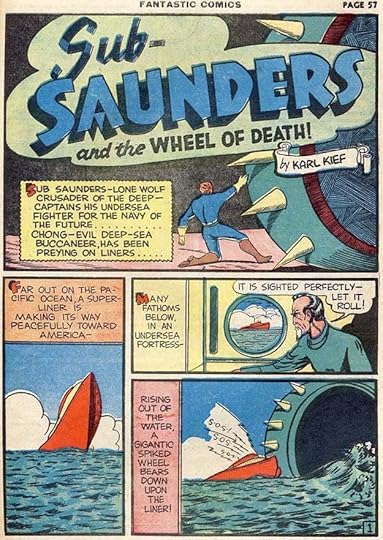 From FANTASTIC COMICS #10, Sept 1940, Fox Publications
From FANTASTIC COMICS #10, Sept 1940, Fox PublicationsIn Part 1 of this article I outlined Howard Ferguson’s life and career as a comics letterer. In this part I’ll look more closely at the lettering itself to see what’s distinctive about it, and then list all the examples I could find, and there are plenty. I’ve arranged them by company roughly in chronological order. Some companies have multiple entries when Howard worked for them at different times.
On the early page above, the title is well-crafted, with touches of Art Deco, like the A in Saunders. AND THE below that uses an angular style of lower case block letters that Howard often returned to. The credit in a scroll is artfully done, and the A in KARL is another style Howard often used especially on credits. He liked wavy lines, you can see them on the outlines of WHEEL OF DEATH, and on the first caption. Decorative first letters in captions or text are something that have been used for centuries, very elaborate ones were featured in medieval manuscripts, and they can be found in many older printed books at the beginning of each chapter. They were sometimes also used in comic strips and comics stories before Ferguson got started in lettering. His are simple but effective, often open letters with a black shape behind. This style was imitated by other letterers who liked it, notably by Gaspar Saladino early in his career. In fact, many of Howard’s “creative extras” were imitated by other letterers. Howard wanted his work to stand out and be noticed. Other letterers tried to up their game by following his lead. You would think this would make identifying his work harder, but to my eye, no one else did them quite like Ferguson.
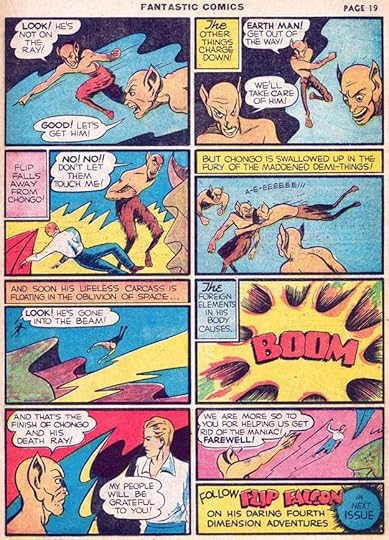 From FANTASTIC COMICS #12, Nov 1940, Fox Publications
From FANTASTIC COMICS #12, Nov 1940, Fox PublicationsOn this story probably done a month or two later, Howard’s regular lettering is looking more even and consistent. Every letterer needs lots of practice to improve, and if you can get paid while doing so, all the better! I see that happening here. One of Ferguson’s characteristic letter shapes is clearer on this page, the C in the balloons has a small down stroke or serif at the top. The script THE at the beginning of two captions is a style Howard often used for that word.
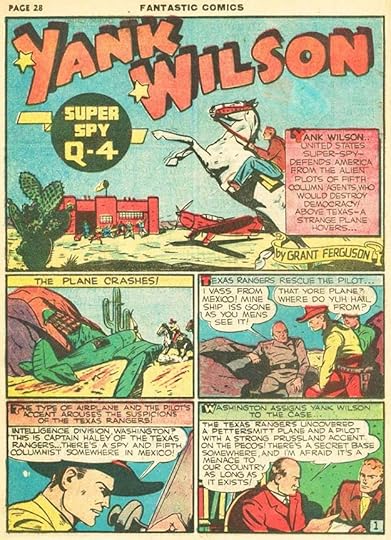 From FANTASTIC COMICS #12, Nov 1940, Fox Publications
From FANTASTIC COMICS #12, Nov 1940, Fox PublicationsAll the features at Fox had creator bylines, in the style of newspaper strips of the time, but most of them were house names, not real people, which kept the actual creators anonymous. This feature’s byline began as Lance Ferguson, but when Howard started lettering it, it became Grant Ferguson, which was Howard’s middle and last name. Does that mean he was doing the art? I doubt it, Howard probably changed the byline as an in-joke, and editor Joe Simon let it ride because he thought it was funny. I imagine few readers noticed.
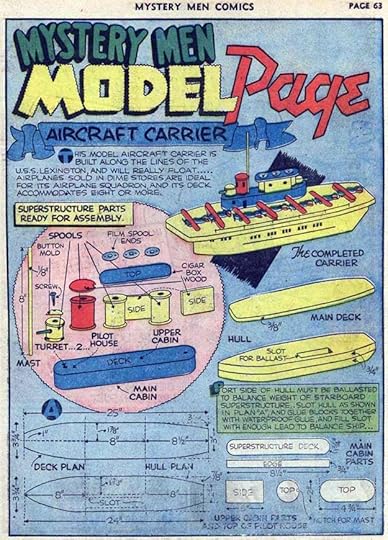 From MYSTERY MEN COMICS #17, Dec 1940, Fox Publications
From MYSTERY MEN COMICS #17, Dec 1940, Fox PublicationsThis is another one-page filler that probably has art by Howard as well as lots of great lettering, and he might have written it. I don’t know that the subject has anything to do with the stories in the issue. Comics set aside a certain number of pages for advertising, and when they weren’t all sold, fillers like this, which had been prepared ahead and held in inventory, could be used. Here we begin the issue and story listings. Many of the comics listed can be read at the COMIC BOOK PLUS website, except for those done for Marvel and DC Comics.
FOX PUBLICATIONS
BIG 3
#1 Fall 1940: Blue Beetle 15pp
#2 Winter 1941: Blue Beetle 15pp
#3 May 1941: Blue Beetle 18pp
#4 July 1941: Blue Beetle 18pp
BLUE BEETLE
#5 Nov 1940: Blue Beetle (1) 10pp, (2) 10pp, (3) 10pp
#6 March-April 1941: Blue Beetle (1) 15pp, (2) 10pp, (3) 10pp, Sub Saunders 8pp
#7 June 1941: Blue Beetle (2) 10pp, (3) 10pp
#8 Aug 1941: Blue Beetle (1) 15pp, (2) 10pp, (4) 10pp
FANTASTIC COMICS
#10 Sept 1940: Flip Falcon 6pp, Sub Saunders 8pp
#11 Oct 1940: Samson 13pp, Flip Falcon 6pp, Sub Saunders 7pp
#12 Nov 1940: Samson 13pp, Flip Falcon 6pp, Yank Wilson 6pp, Sub Saunders 7pp
#13 Dec 1940: Samson & David 13pp, Flip Falcon 6pp, Yank Wilson 5pp Sub Saunders 7pp
#14 Jan 1941: Samson & David 13pp, Flip Falcon 6pp, Yank Wilson pp1-2 only, Sub Saunders 7pp
#15 Feb 1941: Samson & David 13pp, Flip Falcon 6pp, Yank Wilson 6pp, Sub Saunders 7pp
#16 March 1941: Samson & David 13pp, Flip Falcon 6pp, Yank Wilson 6pp, Sub Saunders 7pp
#17 April 1941: Samson & David 13pp, Flip Falcon 6pp, Yank Wilson 6pp, Sub Saunders 7pp
#18 May 1941: Samson & David 13pp, Yank Wilson 6pp, Flip Falcon 6pp, Sub Saunders 7pp
#19 June 1941: Samson & David 13pp, Flip Falcon 6pp, Sub Saunders 7pp
#20 July 1941: Samson & David 13pp, Flip Falcon 6pp, Sub Saunders 6pp
#21 Aug 1941: Samson & David 13pp, Flip Falcon 6pp
#22 Sept 1941: Samson & David 14pp, Yank Wilson 6pp, The Queen of Evil 6pp, Captain Kidd 5pp
MYSTERY MEN COMICS
#14 Sept 1940: Blue Beetle 8pp, Lynx 5pp, D-13 8pp
#15 Oct 1940: Chen Chang 6pp, Lynx 5pp
#16 Nov 1940: Blue Beetle 10pp, Lynx 8pp, Captain Savage 3pp, Zanzibar 4pp
#17 Dec 1940: Blue Beetle 10pp, Lynx 8pp, D-13 8pp, Mystery Men Model Page 1pp
#18 Jan 1941: Blue Beetle 10pp, D-13 8pp, Lynx 8pp
#19 Feb 1941: Blue Beetle 10pp, D-13 8pp, Lynx 8pp
#20 March 1941: Blue Beetle 10pp, Lynx 8pp, D-13 8pp
#21 April 1941: Blue Beetle 10pp, Lynx 8pp, D-13 8pp
#22 May 1941: Blue Beetle 10pp, Lynx 8pp, D-13 8pp
#23 June 1941: Blue Beetle 10pp, Lynx 8pp
#24 July 1941: Blue Beetle 10pp, Lynx 8pp
SAMSON
#4 April 1941: Wing Turner 6pp
SCIENCE COMICS
#7 Aug 1940: Scientific Magic 1pp
#8 Sept 1940: Scientific Magic 1pp, Cosmic Carson 6pp, Scientifacts 1pp, Perisphere Payne 8pp
WEIRD COMICS
#6 Sept 1940: Dart 8pp, Blast Bennett 8pp, Weird Facts 1pp
#7 Oct 1940: Dart 10pp, Sorceress of Zoom 8pp, Weird Facts 1pp story and art (signed)
#8 Nov 1940: Dart 10pp, Marga 8pp
#9 Dec 1940: Dart 10pp, Blast Bennett 6pp, Eagle 10pp, Marga 8pp
#10 Jan 1941: Dart 10pp, Sorceress of Zoom 10pp
#11 Feb 1941: Dart 10pp, Sorceress of Zoom 10pp, Eagle 10pp, Marga 8pp, Blast Bennett 6pp
#12 March 1941: Dart 10pp, Sorceress of Zoom 10pp, Eagle 10pp, Marga 8pp, Blast Bennett 6pp
#13 April 1941: Dart 10pp, Sorceress of Zoom 10pp, Eagle 10pp, Marga 8pp, Blast Bennett 6pp
#14 May 1941: Dart 10pp, Sorceress of Zoom 10pp, Eagle 10pp, Marga 8pp, Blast Bennett 6pp
#15 June 1941: Dart 10pp, Sorceress of Zoom 10pp, Eagle 10pp, Marga 8pp, Blast Bennett 6pp
#16 July 1941: Eagle 10pp, Blast Bennett 6pp
WONDERWORLD COMICS
#17 Sept 1940: Yarko 8pp (includes Yarko Presents his Magic 1/2 page), Dr. Fung 8pp
#18 Oct 1940: Flame 9pp, Dr. Fung 8pp
#19 Nov 1940: Yarko Presents his Magic 1/2 page, Dr. Fung 8pp, Tex Maxon 8pp, Spark Stevens 8pp
#20 Dec 1940: Dr. Fung 8pp, Tex Maxon 8pp, K-51 5pp
#21 Jan 1941: Black Lion 8pp, Tex Maxon 6pp, Dr. Fung 8pp
#22 Feb 1941: Black Lion 8pp, Tex Maxon 6pp, Dr. Fung 8pp
#23 March 1941: Black Lion 8pp, Tex Maxon 6pp, Dr. Fung 8pp
#24 April 1941: Black Lion 8pp, Tex Maxon 6pp, Dr. Fung 8pp
#25 May 1941: Black Lion 8pp, Tex Maxon 6pp
#26 June 1941: Black Lion 8pp, Tex Maxon 6pp, Dr. Fung 8pp
#27 July 1941: Black Lion 8pp, Tex Maxon 6pp, Dr. Fung 8pp
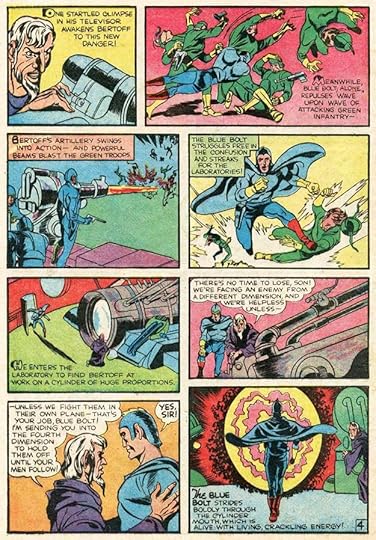 From BLUE BOLT #5, Oct 1940, Novelty Press
From BLUE BOLT #5, Oct 1940, Novelty PressThis Blue Bolt story steps back a bit in chronology. The regular lettering is less even on his early work, but Howard’s creative extras are in place at the beginning of each caption. Novelty Press was a subsidiary of Curtis Publishing, best known for The Saturday Evening Post, a slick magazine of high reputation. That’s probably why the Curtis name was not used on their comics.
NOVELTY PRESS / CURTIS
BLUE BOLT
#5 Oct 1940: Blue Bolt 10pp
#6 Nov 1940: Blue Bolt 10pp
#7 Dec 1940: Blue Bolt 10pp
#8 Jan 1941: Blue Bolt 10pp
#9 Feb 1941: Blue Bolt 10pp
#10 March 1941: Blue Bolt 10pp
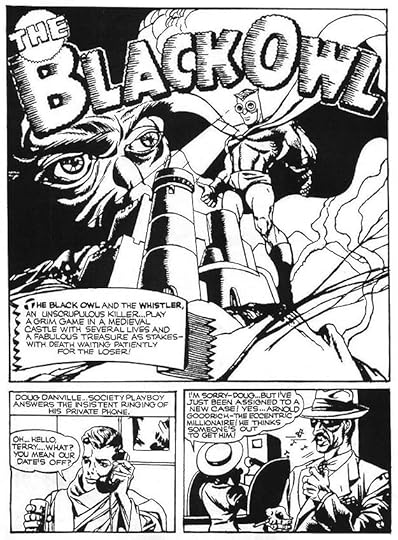 From PRIZE COMICS #7, Dec 1940, Prize
From PRIZE COMICS #7, Dec 1940, PrizeThis lettering was probably done at least a month or two later than the previous example, as it’s more confident, and might be done with a wedge-tipped pen to give the lines variety, though it’s a bit hard to tell on this scan. Another Ferguson style point has emerged, the letter G has a horizontal serif in the middle extending both ways. Howard didn’t always do this, and did it less late in his career, but for a number of years it’s a good clue for identification. The character logo again uses wavy lines. One advantage of that is it hides small design flaws and is quicker than ruling straight lines. It also adds atmosphere.
PRIZE (Part 1)
PRIZE COMICS
#7 Dec 1940: Black Owl 9pp
#9 Feb 1941: Black Owl 9pp, Ted O’Neil 6pp
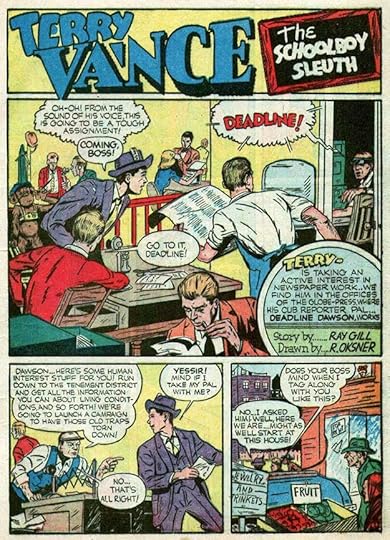 From MARVEL MYSTERY COMICS #15, Jan 1941, image © Marvel
From MARVEL MYSTERY COMICS #15, Jan 1941, image © MarvelWhen Simon and Kirby began working for Timely, as Marvel Comics was known then, Howard of course came with them. I’m not sure if he had a seat in the bullpen alongside Jack Kirby, or worked at home, probably both. This early effort does not involve Kirby, and may not involve Simon either except perhaps as editor. It’s a rare example for the time with a writer credit, and the art is by long-time veteran Bob Oksner at the start of his career. Howard was still working out balloon shapes, the first one in the top panel is a thought balloon with many small scallops on the edge, but it doesn’t connect to the same person’s speech balloon below it. The boss’s burst balloon shape is an odd mix of scalloped edges, radiating line pairs, and a jagged tail. The open letters of the word inside get the emphasis across best. The regular lettering is now definitely being done with a wedge-tipped pen, which adds variety and interest to the letters.
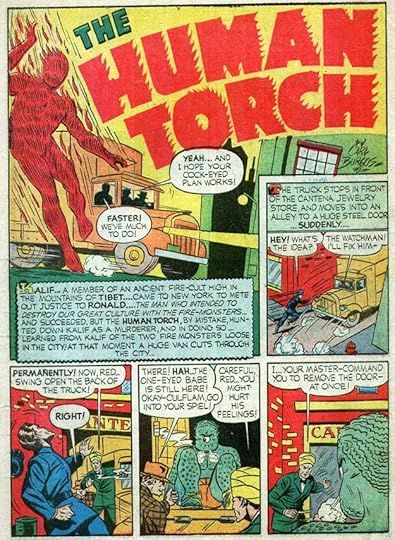 From MARVEL MYSTERY COMICS #15, Jan 1941, image © Marvel
From MARVEL MYSTERY COMICS #15, Jan 1941, image © MarvelFollowing Simon and Kirby into Timely/Marvel, Ferguson was able to letter some of their other existing features they didn’t write or draw, like this one. Here I don’t like the wavy panel border as much. Note that Howard adds emphasis to words by making them bold but not italic at this point.
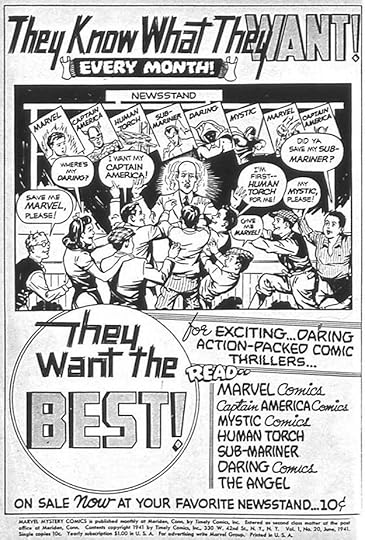 From MARVEL MYSTERY COMICS #20, June 1941, image © Marvel
From MARVEL MYSTERY COMICS #20, June 1941, image © MarvelHere’s a great house ad by Howard with lots of creative styles and dynamic lettering, no doubt commissioned by editor Joe Simon. The overlap of THEY and WANT on the first line is risky, but it reads fine. I don’t know who did the art.
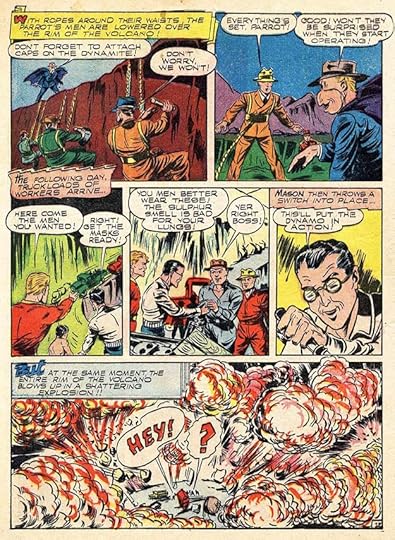 From MARVEL MYSTERY COMICS #26, Dec 1941, image © Marvel
From MARVEL MYSTERY COMICS #26, Dec 1941, image © MarvelFrom near the end of his Marvel work, the regular letters on this page are stretched horizontally, but still appealing. The caption styles are varied and creative. Howard didn’t do typical burst balloons in the last panel, but they work fine, even though he forgot to connect the tail on the left one. I don’t see any other lettering by Ferguson that’s this wide, perhaps it was an experiment he didn’t stay with.
TIMELY / MARVEL COMICS
ALL-WINNERS COMICS
#1 Summer 1941: Black Marvel 12pp, Captain America 13pp
#2 Fall 1941: Captain America pages 4-6, 8-9 only
CAPTAIN AMERICA COMICS
#1 March 1941: Table of Contents 1pp, Captain America (4 stories) 8pp, 7pp, 16pp, 14pp, USA Comics House Ad 1pp
#2 April 1941: Possible partial pages in first story, A Message From Captain America House Ad 1pp
#4 June 1941: Captain America (story 1) pages 1-10 only, (story 3) 10pp (story 4) 13pp
#5 Aug 1941: Captain America (4 stories) 12pp, 15pp, 10pp, 6pp, Sentinels of Liberty House Ad 1pp, Headline Hunter 5pp, Hurricane 8pp
#6 Sept 1941: Captain America (3 stories) 16pp, 9pp, 16pp
#7 Oct 1941: Captain America (3 stories) 13pp, 15pp, 13pp
#8 Nov 1941: Captain America (3 stories) 13pp, 11pp, 17pp
#9 Dec 1941: Captain America (3 stories) 11pp, 13pp, 18pp
#10 Jan 1942: Captain America (3 stories) 11pp, 13pp, 16pp
DARING MYSTERY COMICS
#6 Sept 1940: Marvel Boy pp1-3 only
#8 Jan 1942: Silver Scorpion 8pp, Captain Daring 6pp
HUMAN TORCH
#2 Fall 1940: Fiery Mask 10pp
#4 Spring 1941: Human Torch (2 parts) 40pp
#5A Summer 1941: Human Torch (2 parts) 40pp
#5B Fall 1941: Human Torch (3 parts) 60pp
#6 Winter 1941: Human Torch (story 2) 18pp
#7 Spring 1942: Human Torch (2 stories) 20pp, 18pp
MARVEL MYSTERY COMICS
#13 Nov 1940: Terry Vance 7pp
#14 Dec 1940: Human Torch 12pp, Terry Vance 7pp
#15 Jan 1941: Human Torch 12pp, Terry Vance 7pp
#16 Feb 1941: Human Torch 15pp, Terry Vance 7pp
#18 April 1941: Human Torch 15pp, Vision 6pp
#19 May 1941: Human Torch 15pp, Terry Vance 7pp
#20 June 1941: Human Torch 15pp, Terry Vance 7pp, Angel 9pp
#21 July 1941: Human Torch 15pp, Terry Vance 7pp, Patriot 5pp, Vision 7pp
#22 Aug 1941: Terry Vance 7pp, Patriot 5pp
#23 Sept 1941: IFC House Ad 1pp, Human Torch 15pp, Patriot 5pp, Vision 7pp, Angel 9pp
#24 Oct 1941: Human Torch 15pp, Terry Vance 7pp, Vision 7pp, Angel 9pp
#25 Nov 1941: Vision 7pp, Angel 9pp
#26 Dec 1941: Human Torch 15pp, Angel 9pp
#27 Jan 1942: Human Torch 15pp, Terry Vance 7pp, Patriot 5pp, Angel 9pp
#28 Feb 1942: Human Torch 15pp, Patriot 6pp
#29 March 1942: Human Torch 15pp, Patriot 6pp
MYSTIC COMICS
#6 Oct 1941: Black Marvel 8pp
SUB-MARINER COMICS
#1 Spring 1941: Sub-Mariner (first story) page 1 only, (second story) 20pp, The Angel 20pp
#2 Summer 1941: Sub-Mariner (story 2) 20pp
U.S.A. COMICS
#1 Aug 1941: Defender intro page 1pp, Mr. Liberty 10pp
YOUNG ALLIES
#1 Summer 1941: Young Allies (6 chapters) 9pp, 10pp, 10pp, 10pp, 9pp, 9pp
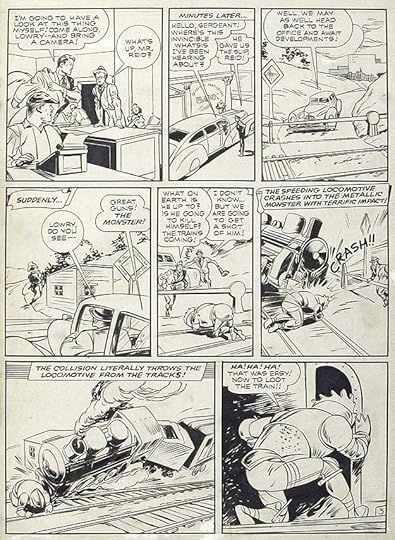 From GREEN HORNET COMICS #9, Oct 1942, Harvey
From GREEN HORNET COMICS #9, Oct 1942, HarveySimon and Kirby did a small amount of work for Harvey at the same time they were at DC, so I’m putting it first. Here, Howard’s balloons have thinner borders, and are becoming more stylized, with perfectly round ends probably done with a circle template, and straight-edged horizontals. His question marks had been inconsistent, here he’s settled on the style he would use going forward, which looks like a small 2 over a dot.
HARVEY (Part 1)
CHAMP COMICS
#23 Oct 1942: Flags of the 28 United Nations (story & art) 2pp
GREEN HORNET
#9 Oct 1942: Green Hornet (2 stories) 8pp, 8pp, Spirit of ’76 7pp, Blonde Bomber 6pp, Zebra 8pp
#10 Dec 1942: Green Hornet (2 stories) 12pp, 8pp, Spirit of ’76 7pp, Blonde Bomber 6pp, Zebra 8pp
#11 Feb 1943: Green Hornet (first 2 stories) 10pp, 8pp, Mr. Q 8pp
#12 April 1943: Spirit of ’76 7pp
#13 July 1943: Green Hornet (first story) 10pp
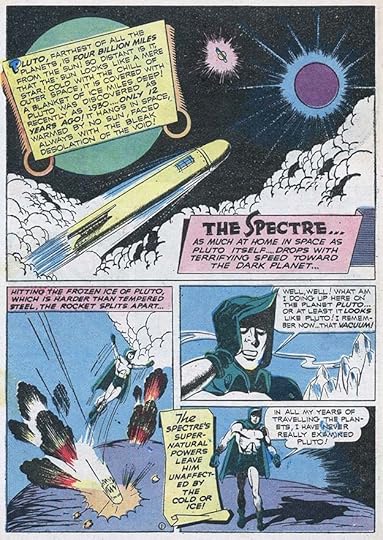 From ALL-STAR COMICS #13, Oct 1942, image © DC Comics
From ALL-STAR COMICS #13, Oct 1942, image © DC ComicsDC had a sister company, All-American, where Simon and Kirby stories also appeared, though this one is not by them, so I don’t know how Howard came to letter it. It has his creative extras and style points. The regular letters lean to the left more than usual, and now his emphasized words are bold and italic, as is more typical.
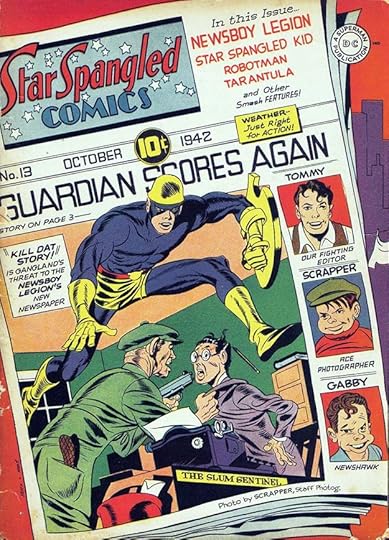 Front cover of STAR SPANGLED COMICS #13, Oct 1942, image © DC Comics
Front cover of STAR SPANGLED COMICS #13, Oct 1942, image © DC ComicsDC had their own regular cover letterers like Ira Schnapp, but this one is clearly by Howard, and it’s a beauty over a great layout by Kirby, an effective design in every way.
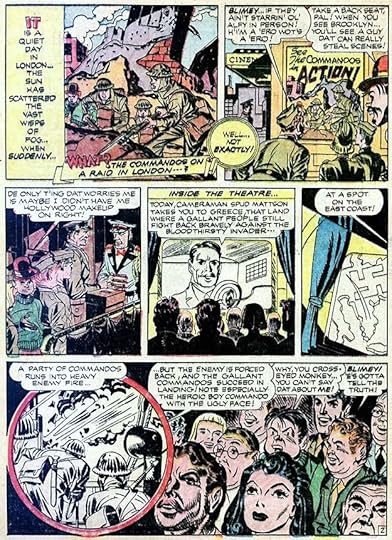 From BOY COMMANDOS 3, Summer 1943, image © DC Comics
From BOY COMMANDOS 3, Summer 1943, image © DC ComicsYou can see everyone in top form on early issues of BOY COMMANDOS, including Howard. This again has the more stylized balloon shapes, and one round caption has a triple border. Even the poster lettering in the second panel stands out.
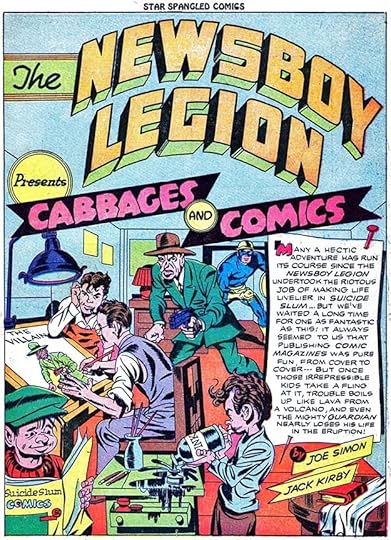 From STAR SPANGLED COMICS #29, Feb 1944, image © DC Comics
From STAR SPANGLED COMICS #29, Feb 1944, image © DC ComicsOne of the last Simon and Kirby stories produced before they went into military service, and what a fun one, with great Ferguson lettering. His regular letters seem a little smaller than usual.
NATIONAL (DC) COMICS
ADVENTURE COMICS
#77 Aug 1942: Hourman 8pp
#78 Sept 1942: Hourman 8pp, Sandman 10pp
#79 Oct 1942: Hourman 8pp, Manhunter 9pp, Sandman 10pp
#80 Nov 1942: Sandman 10pp
#81 Dec 1942: Sandman 10pp
#82 Jan 1943: Sandman 10pp
#83 Feb 1943: Sandman 10pp
#84 March 1943: Sandman 10pp
#85 April 1943: Sandman 10pp, Manhunter 9pp
#86 June-July 1943: Sandman 10pp, Manhunter 9pp
#87 Aug-Sept 1943: Sandman 10pp, Manhunter 9pp
#88 Oct-Nov 1943: Sandman 10pp, Starman 9pp
#89 Dec 1943-Jan 1944: Sandman 10pp, Manhunter 9pp
#90 Feb-March 1944: Sandman 10pp, Manhunter 9pp
ALL-STAR COMICS
#13 Oct-Nov 1942: Spectre 6pp
#14 Dec 1942/Jan 1943: Sandman 6pp
#15 Feb-March 1943: Sandman 6pp
#16 April-May 1943: Sandman 6pp
#17 June-July 1943: Sandman 6pp
#19 Winter 1943: Sandman 5pp
BOY COMMANDOS
#1 Winter 1942-43: Boy Commandos (4 stories) 12pp, 12pp, 12pp, 12pp
#2 Spring 1943: Front Cover, Boy Commandos (4 stories) 12pp, 12pp, 13pp, 9pp
#3 Summer 1943: Boy Commandos (4 stories) 12pp, 10pp, 12pp, 11pp
#4 Fall 1943: Boy Commandos (Chapter 1 only) 6pp
#5 Winter 1943: Boy Commandos (stories 1, 3-4) 13pp, 10pp, 12pp
#6 Spring 1944: Boy Commandos (stories 1 & 4) 11pp, 11pp
DETECTIVE COMICS
#66 Aug 1942: Boy Commandos pages 1, 8-12 only
#67 Sept 1942: Boy Commandos 12pp
#68 Oct 1942: Boy Commandos 12pp
#69 Nov 1942: Boy Commandos 12pp
#70 Dec 1942: Boy Commandos 12pp
#71 Jan 1943: Boy Commandos 12pp
#72 Feb 1943: Boy Commandos 12pp
#73 March 1943: Boy Commandos 12pp
#74 April 1943: Boy Commandos 12pp
#75 May 1943: Boy Commandos 12pp
#76 June 1943: Boy Commandos 12pp
#77 July 1943: Boy Commandos 12pp
#78 Aug 1943: Boy Commandos 12pp
#79 Sept 1943: Boy Commandos 12pp
#80 Oct 1943: Boy Commandos 12pp
#81 Nov 1943: Boy Commandos 12pp
#82 Dec 1943: Boy Commandos 11pp
#83 Jan 1944: Boy Commandos 12pp
#85 March 1944: Boy Commandos 12pp
WORLD’S FINEST COMICS
#8 Winter 1942: Boy Commandos 13pp
#9 Spring 1943: Boy Commandos 13pp
#10 Summer 1943: Boy Commandos 12pp
#11 Fall 1943: Boy Commandos 12pp
#12 Winter 1943: Boy Commandos 10pp
#15 Fall 1944: Boy Commandos 12pp
STAR SPANGLED COMICS
#12 Sept 1942: Newsboy Legion 13pp
#13 Oct 1942: Front Cover, Newsboy Legion 13pp
#14 Nov 1942: Newsboy Legion 13pp
#15 Dec 1942: Newsboy Legion 13pp
#16 Jan 1943: Newsboy Legion 13pp
#17 Feb 1943: Newsboy Legion 13pp
#18 March 1943: Newsboy Legion 13pp
#19 April 1943: Newsboy Legion 13pp
#20 May 1943: Newsboy Legion 13pp
#21 June 1943: Newsboy Legion 12pp
#22 July 1943: Newsboy Legion 13pp
#23 Aug 1943: Newsboy Legion 13pp
#24 Sept 1943: Newsboy Legion 13pp
#25 Oct 1943: Newsboy Legion 10pp
#26 Nov 1943: Newsboy Legion 13pp
#27 Dec 1943: Newsboy Legion 11pp
#28 Jan 1944: Newsboy Legion 11pp
#29 Feb 1944: Newsboy Legion 11pp
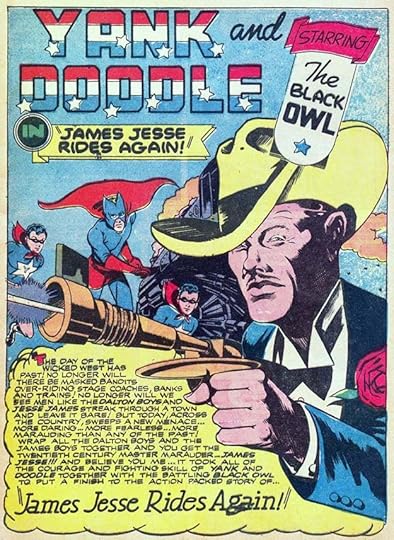 From PRIZE COMICS #40, March 1944
From PRIZE COMICS #40, March 1944With Simon and Kirby away, the studio broke up, and Howard found work at Prize. These feature logos and title are stellar.
PRIZE (Part 2)
PRIZE COMICS
#36 Nov 1943: Transpo-Hank (magic trick) 1pp
#37 Dec 1943: Yank & Doodle & Black Owl 12pp, Magic Marksman 1pp
#38 Jan 1944: Yank & Doodle & Black Owl 12pp, Flying Fist’s Magic Page (art & lettering) 1pp
#39 Feb 1944: Yank & Doodle 12pp, Through the Looking Glass 1pp
#40 March 1944: Yank & Doodle & Black Owl 12pp, Ted O’Neil 8pp, Flying Fist Magic Page 1pp
#41 April 1944: Yank & Doodle & Black Owl 12pp, Flying Fist & Bingo 8pp
#42 June 1944: Yank & Doodle & Black Owl 12pp, Ted O’Neil 8pp, Worldbeater & Unghh 8pp, Airmale 8pp, Flying Fist & Bingo 8pp
#43 July 1944: Yank & Doodle & Black Owl 12pp, Worldbeater & Unghh 8pp, Airmale 8pp
#44 Aug 1944: Boom Boom Brannigan 12pp
#45 Sept 1944: Boom Boom Brannigan 12pp
#46 Oct 1944: Boom Boom Brannigan 12pp
#47 Nov 1944: Boom Boom Brannigan 12pp
#48 Dec 1944: Worldbeater 8pp
#49 Jan 1945: Boom Boom Brannigan 12pp, Strange Facts Scrapbook 1pp, Prize Comics Magic Page 1pp
#50 Feb 1945: Boom Boom Brannigan 12pp, Prize Comics Magic Page 1pp
#52 April 1945: Boom Boom Brannigan 12pp, Ham & Eggs 5pp, Herc 1pp, Sir Prize 7pp
#53 May-June 1945: Boom Boom Brannigan 12pp, Peter Pelican 6pp, Sir Prize 7pp, Yank & Doodle & Black Owl 9pp
#54 July-Aug 1945: Boom Boom Brannigan 12pp, Yank & Doodle & Black Owl 9pp, Caveman Frolics 6pp, Sir Prize 7pp
#55 Sept-Oct 1945: Boom Boom Brannigan 12pp, Sir Prize 7pp, Jason 8pp, ‘Tis True 1pp, Yank & Doodle & Black Owl 9pp
#56 Nov-Dec 1945: Sir Prize 7pp, Yank & Doodle & Black Owl 9pp, Jason 8pp, Boom Boom Brannigan 12pp
#57 Jan-Feb 1946: Sir Prize 7pp, Yank & Doodle & Black Owl 8pp, Boom Boom Brannigan 12pp
#58 March-April 1946: Sir Prize 7pp, Yank & Doodle & Black Owl 8pp, Boom Boom Brannigan 12pp
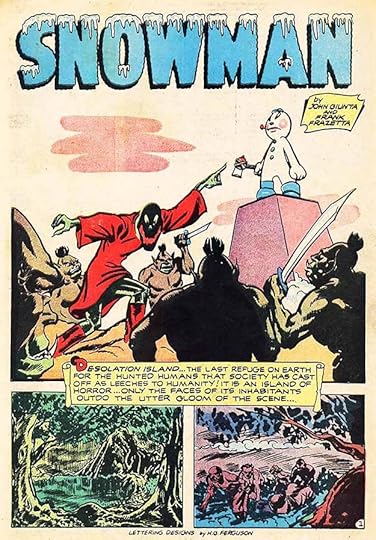 From TALLY HO (no number), Dec 1944, Baily
From TALLY HO (no number), Dec 1944, BailyThis odd one-shot is famous as the first published comics credit for legendary artist Frank Frazetta. It also has a rare lettering credit added by Ferguson. He was picking up odd jobs where he could. This is the earliest lettering credit in comics that I know of. It might be the first.
BAILY PUBLISHING
TALLY HO
No number, Dec 1944: Snowman 8pp
CAMBRIDGE HOUSE
STAR STUDDED COMICS
No number, 1945: Captain Combat 8pp, Ghost Woman 8pp, Commandette 8pp, Red Rogue 8pp
SPOTLIGHT PUBLISHERS
BEE 29 THE BOMBARDIER
#1 Feb 1945: Gee Gee the Talking Horse 6pp, Spot & Dot 6pp, Eeny Meeny & Moe 6pp
TWINKLE COMICS
#1 May 1945: Adventure in Africa 5pp, Hooch & Pooch 7pp, G.I. Fun 1pp, Hop & Pop 4pp, Ella 4pp, Superstitious Aloysius 6pp
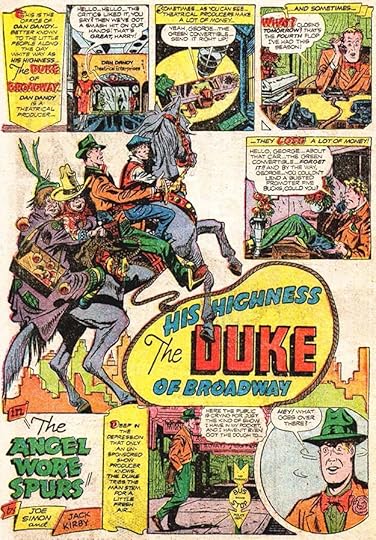 From STUNTMAN #2, June-July 1946, Harvey
From STUNTMAN #2, June-July 1946, HarveyBack in New York, Simon and Kirby’s work never looked better, and Ferguson’s lettering is also excellent, but the new titles didn’t sell, and Howard was facing the personal tragedy of his wife’s death.
HARVEY (Part 2)
ALL-NEW COMICS
#13 July-Aug 1946: Stuntman page 1 only
BLACK CAT COMICS
#4 Feb-March 1947: Danny Dixon Cadet 7pp, Soapy Sam 3pp
#5 April-May 1947: Danny Dixon Cadet 7pp, Duke of Broadway 10pp
#6 June-July 1947: Danny Dixon 6pp, Duke of Broadway 9pp
#7 Aug-Sept 1947: Duke of Broadway 10pp, Vagabond Prince 10pp
#8 Oct-Nov 1947: Vagabond Prince 12pp
BOY EXPLORERS
#1 May-June 1946: Boy Explorers 12pp, Duke of Broadway 12pp
#2 Sept-Oct 1946: Boy Explorers 14pp
JOE PALOOKA COMICS
#5 July-Aug 1946: Boy Explorers 6pp
STUNTMAN
#1 April-May 1946: Stuntman (3 stories) 13pp, 10pp, 12pp
#2 June-July 1946: Stuntman (2 stories) 12pp, 12pp, Duke of Broadway 10pp
#3 Oct-Nov 1946: Stuntman 12pp
TERRY AND THE PIRATES
#3 April 1947: Boy Explorers 8pp
#4 June 1947: Boy Explorers 6pp
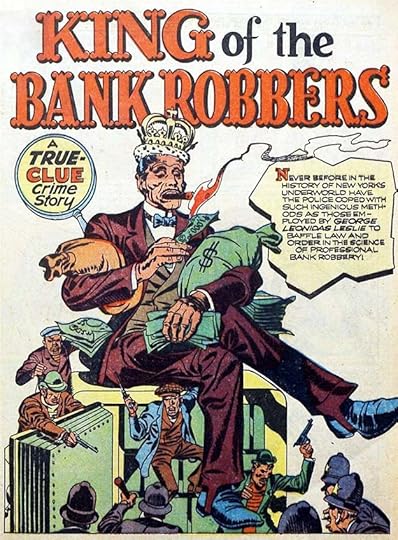 From CLUE COMICS #13, March 1947, Hillman
From CLUE COMICS #13, March 1947, HillmanWhat a beautiful circus-style title on this story, the only one I found lettered by Howard at Hillman.
HILLMAN
CLUE COMICS
#13 March 1947: King of the Bank Robbers 8pp
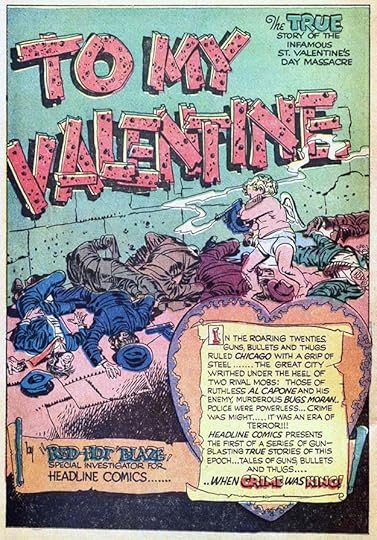 From HEADLINE COMICS #23, March-April 1947
From HEADLINE COMICS #23, March-April 1947At Prize again, Howard was present for the beginnings of Simon and Kirby’s crime comics, but then his work stopped when he moved to Detroit for two years. This story title is amazing. There are subtle changes in his regular lettering, the small serifs in the C and G are gone.
PRIZE (Part 3)
HEADLINE COMICS
#23 March-April 1947: The Last Bloody Days of Baby Face Nelson 7pp, The Doctor is Missing 6pp, Red-Hot Blaze (2 stories) 7pp, 8pp, Crime Through the Ages 10pp, Comi-Crime 5pp
#24 May-June 1947: Red-Hot Blaze (4 stories) 9pp, 7pp, 8pp, 4pp, Grim Pay-Off for the Pin-Ball Mob 7pp, You Can’t Forget a Killer 8pp
#25 July-Aug 1947: Front Cover, Red-Hot Blaze (2 stories) 7pp, 7pp, Pay Up or Die 7pp, Comi-Crime 4pp
#27 Nov-Dec 1947: Front Cover 1pp
JUSTICE TRAPS THE GUILTY
#1 Oct-Nov 1947: Front Cover 1pp
YOUNG ROMANCE
#1 Sept-Oct 1947: Front Cover 1pp
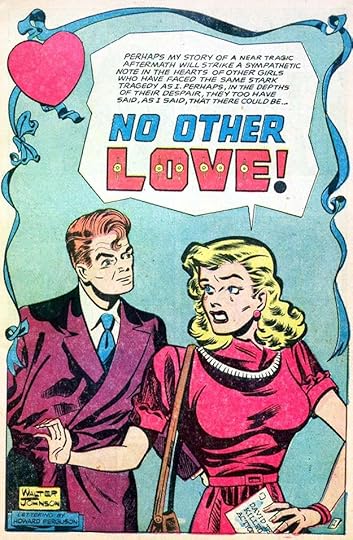 From ROMANTIC LOVE #1, Sept-Oct 1949, Avon
From ROMANTIC LOVE #1, Sept-Oct 1949, AvonWhen he got back to New York in 1948, no work was forthcoming from Simon and Kirby, so Howard picked up what he could elsewhere. This story has his lettering credit.
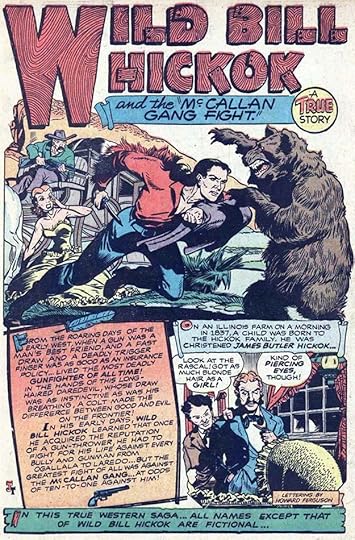 From WILD BILL HICKOK #1, Sept-Oct 1949, Avon
From WILD BILL HICKOK #1, Sept-Oct 1949, AvonSo does this one, and there’s a magnificent feature logo by Howard. I think he was trying to establish his lettering credentials, but at the time letterers were rarely allowed to put their own name on stories. Somehow Ferguson managed it. I’ve included work on COW PUNCHER COMICS here from 1946, probably done before Ferguson went back to Detroit for two years.
AVON
COW PUNCHER COMICS
#6 March 1947: White Brother 6pp
#7 May 1947: Six-Shooter Serenade 8pp, Gold Makes a Ghost Town 8pp
ROMANTIC LOVE
#1 Sept-Oct 1949: No Other Love 11pp
SLAVE GIRL COMICS
#2 April 1949: Malu 10pp, Lost Princess 6pp, Malu 10pp, Flame Goddess 7pp
THE SAINT
#5 Feb 1949: The Saint (first story) 8pp
#6 April 1949: The Saint (stories 2 & 3) 6pp, 6pp
#7 Aug 1949: The Saint (first story) 8pp, (second story) page 1 only (third story) 10pp, Flash Harper 6pp
THE UNDERWORLD STORY
No number, 1950: Frosty Dugan 7pp
WILD BILL HICKOK
#1 Sept-Oct 1949: Wild Bill Hickok (2 stories) 10pp, 10pp
#2 Dec 1949-Jan 1950: Wild Bill Hickok (first story) 11pp, Kit West 10pp
#3 Feb-March 1950: White Brother 8pp
#4 July 1950: Showdown at Massacre Creek 7pp
#5 Oct 1950: Jeff Venture 8pp
GILBERTON
CLASSICS ILLUSTRATED
#59 May 1949: Wuthering Heights by Emily Bronte 44pp
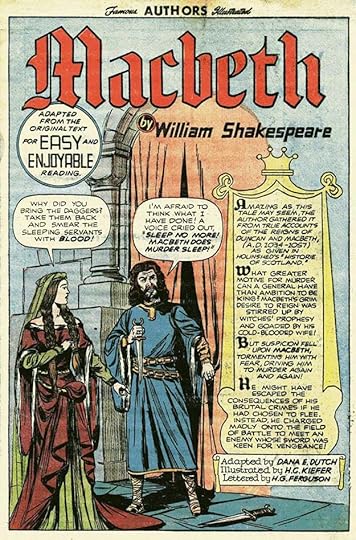 From STORIES BY FAMOUS AUTHORS ILLUSTRATED #6, Aug 1950, Seaboard
From STORIES BY FAMOUS AUTHORS ILLUSTRATED #6, Aug 1950, SeaboardAnother example of Howard getting in his lettering credit, and fine work by him with lots of creative extras.
SEABOARD PUBLISHING
STORIES BY FAMOUS AUTHORS ILLUSTRATED
#6 Aug 1950: Macbeth by Shakespeare 30pp
#7 Sept 1950: The Window by Cornell Woolrich 45pp
#8 Oct 1950: Hamlet by Shakespeare 29pp
ST. JOHN
AUTHENTIC POLICE CASES
#14 Aug 1951: Diamonds C.O.D. 8pp, Police Smash Waterfront Crime Gangs 8pp
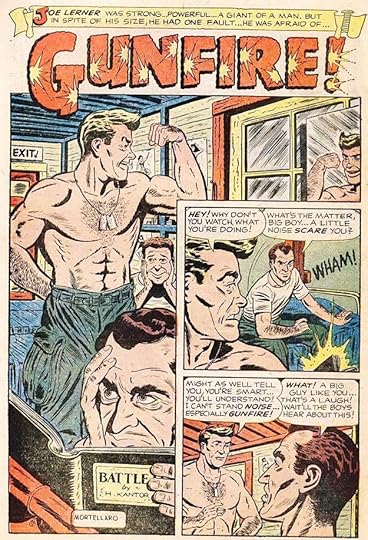 From BATTLE CRY #4, May 1952, Stanley Morse
From BATTLE CRY #4, May 1952, Stanley MorseA beautiful title by Howard. His regular lettering continues with the revised C and G, and retains the small, angular question mark. The top caption is as stylish as ever.
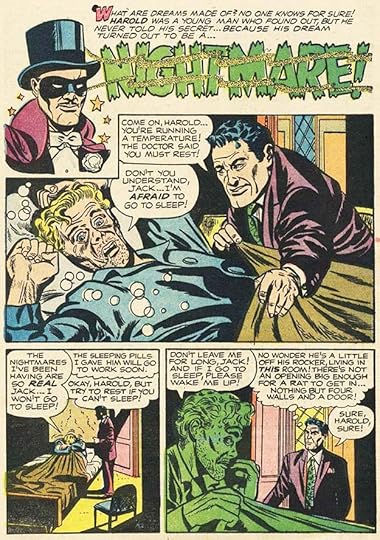 From MISTER MYSTERY #15, Feb 1954
From MISTER MYSTERY #15, Feb 1954Another creative title, I’m not sure how the ribbon-like texture areas were done. I haven’t talked about Howard’s letter J, it has a distinctive shape here and throughout his career, but it’s not a letter that shows up that often.
STANLEY MORSE
BATTLE CRY
#1 May 1952: Tale of a Tank 4pp
#2 July 1952: Section 8 7pp, Operation Exterminator 5pp, Meter Reader 6pp, A Plot of Land 4pp, A Pint of Plasma 5pp
#3 Sept 1952: Glory Hound 6pp, To the Victors 4pp, A Modern Army 5pp, Machinery 4pp, Gambler 6pp
#4 Nov 1952: Treatment 6pp, Gunfire 5pp, Paratrooper Boots 5pp, Buddies 5pp
#5 Jan 1953: Plan of Attack 5pp, Bawl Like a Baby 5pp, Infiltration 5pp, Going Home 5pp, Frustration 4pp
#6 March-April 1953: Up In Smoke 5pp, Dragon from the East 4pp, A Pair of Dice 6pp, Steel Foxhole 5pp
#7 May-June 1953: Run to Murmansk 5pp
#8 Aug-Sept 1953: Operation Rx 4pp
MISTER MYSTERY
#15 Feb 1954: Nightmare 4pp
WEIRD TALES OF THE FUTURE
#2 June 1952: City of Primitive Man 7pp
#3 Sept 1952: Desert Castle 6pp
#4 Nov 1952: Day of Doom 7pp, Engine That Came Through Time 7pp, Speck of Stardust 7pp
#5 Jan 1953: The Worm Turns 4pp, Else You’ll Be Dead 4pp, Under Her Thumb 4pp, Torture 4pp
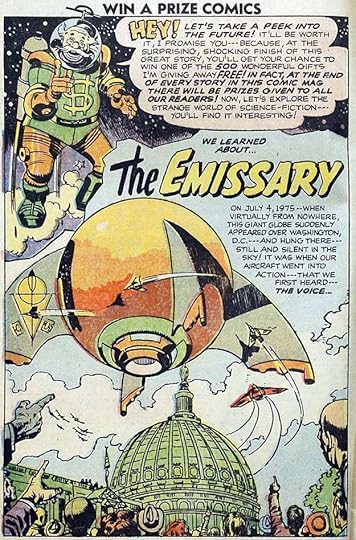 From WIN A PRIZE COMICS #1, Feb 1955, Charlton
From WIN A PRIZE COMICS #1, Feb 1955, CharltonHoward reconnected with Simon and Kirby in 1954, doing work like this for Charlton. His regular lettering is looking a bit uneven here, and he’s gone back to the serif G. Or could this be old work that sat in Simon and Kirby inventory for years? Joe Simon said in his book that rarely happened, they usually were able to sell everything they did.
CHARLTON
CHARLIE CHAN
#6 June 1955: Front Cover, Charlie Chan (3 stories) 6pp, 7pp, 7pp
#7 Aug 1955: Charlie Chan (first story) 6pp, (second story) page 1 top panel only
FROM HERE TO INSANITY
#11 Aug 1955: Front Cover, Expressions 1pp, Line ‘Em Up 2pp, Dorothy and Digby 4pp, Rex Mortgage M.D. 3pp, Walt Chisely’s 20,000 Lugs Under the Sea 6pp, Build It Yourself 4pp, Comet Feldmeyer 2pp, Tweetie Piper 1pp, Be A Successful 90-Pound Weakling 1pp
WIN A PRIZE COMICS
#1 Feb 1955: Uncle Giveaway 1pp, The Emissary 6pp, Win A Prize 1pp
#2 April 1955: Bullet Ballad 7pp, Sir Cashby of Moneyvault 4pp, Torpedoed 4pp, The Handsome Brute 5pp, The Bull 5pp
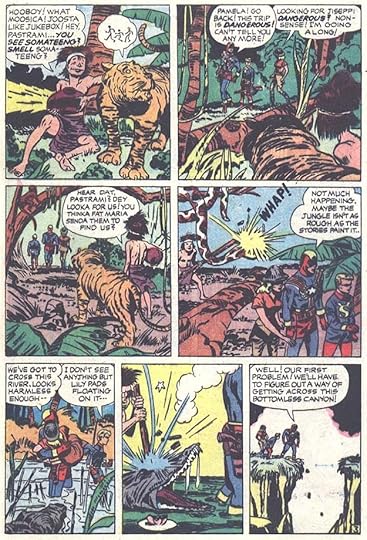 From FIGHTING AMERICAN #5, Dec 1954-Jan 1955, Prize
From FIGHTING AMERICAN #5, Dec 1954-Jan 1955, PrizeWhen Ferguson also returned to Simon and Kirby work at Prize, taking over titles like this from Ben Oda, his lettering was subdued with few creative extras, but look at that clever balloon for the tiger in the first panel! Here the G again has a serif, something that seemed to come and go.
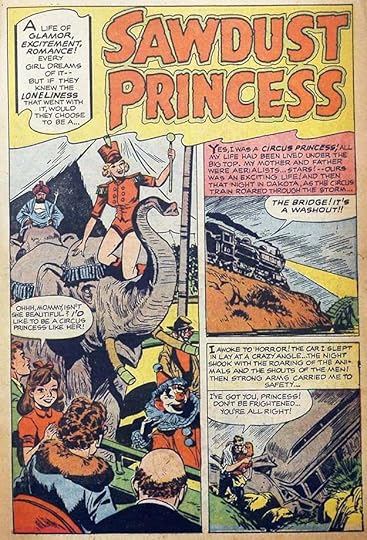 From YOUNG ROMANCE #90, Nov 1957
From YOUNG ROMANCE #90, Nov 1957Right at the end of his career, Ferguson’s lettering sometimes became more uneven, but he always came through with beautiful story titles. Here the G is without a serif again, but look at the familiar question mark and stylish opening caption.
PRIZE (Part 4)
FIGHTING AMERICAN
#5 Dec 1954-Jan 1955: Fighting American (3 stories) 8pp, 8pp, 6pp
#6 Feb-March 1955: Fighting American (3 stories) 8pp, 4pp, 10pp
#7 April-May 1955: Front Cover, Fighting American (3 stories) 8pp, 7pp, 5pp
YOUNG BRIDES
#21 March-April 1955: Front Cover, Cheating Lady 6pp, Marriage at Work 6pp, Bad Impression 7pp, Fair Weather Love 6pp
#22 May-June 1955: Those Two 6pp, The Pianist 6pp, Dream Love 6pp, Trail’s End 6pp
#23 July-Aug 1955: That Manning Boy 6pp, Steady Beau 2pp, Impossible Love 6pp, Ask Dan Wilson 2pp, The Day I Grew Up 6pp
#24 Sept-Oct 1955: Front Cover, Ask Mother 6pp, Bitter Bride 6pp, Riches or Romance? 6pp
#25 Nov-Dec 1955: Cafe Society Lover 8pp, A Little Understanding 6pp, Last Hope 6pp, Her Beautiful Visitor 5pp
#26 Jan-Feb 1956: Lydia’s Boy 7pp, Since You Got Glamour 6pp, Love & Lamb Chops 5pp, Dream Man 7pp
#27 March-April 1956: Front Cover, Good Marriage 7pp, Second Choice 6pp, Sad Wedding 5pp, Unattached Male 7pp
#28 May-June 1956: Front Cover, If You Could Only Cook 5pp, Under New Management 7pp, Aide to Marriage 6pp, New Boy in Town 7pp
#29 July-Aug 1956: Sound of Wedding Bells 6pp, Shadow-Wife 6pp, Nancy’s Sanctuary 6pp, Romance on the Run 7pp
#30 Nov-Dec 1956: In Love with a Tomboy 6pp, Here Comes the Bride 6pp, Family Jinx 6pp, The Way They Met 1pp, Unhappy Housewife 6pp
YOUNG LOVE
#64 April-May 1955: Kissing Game 6pp, Weeping Widow 6pp, Love Me, Love My Sister 6pp. Lovely Little Faker 6pp
#65 June-July 1955: Who Keeps the Faith 6pp, The Wild One 6pp, Foolishly Wise 6pp, Get Out of Town 7pp
#66 Aug-Sept 1955: Just for Spite 6pp, Till the End of Time 6pp, Past Mistakes 6pp
#69 Feb-March 1956: Front Cover, How’s the Family? 7pp, Bright Boy 6pp, Lady in the Jaguar 6pp, Girls Next Door 6pp
#70 April-May 1956: Front Cover, Too Late for Love 6pp, Big Disappointment 8pp, A Week in Frisco 5pp, Lovely Little Copycat 6pp
#71 June-July 1956: Easy Way Out 6pp, Love That Money 6pp, Birthday Present 7pp
#72 Oct-Nov 1956: And My Heart Came Tumbling Down 7pp, Love and War 6pp, Cinderella Story 6pp, I Dream of Jeannie 6pp
#73 Dec 1956-Jan 1957: Torch Song 7pp, Soldier’s Homecoming 6pp, Bust-up 6pp
YOUNG ROMANCE
#76 April 1955: Let’s Pretend 6pp, Lovesick Meddler 6pp, Unpleasingly Plump 4pp, Lover’s Helper 7pp
#77 June-July 1955: Security of Love 6pp, The Hangout 6pp, The Big Fish 6pp, My Husband’s Keeper 7pp
#78 Aug-Sept 1955: Front Cover, Meddling Mother-in-Law 2pp, What’s the Catch? 6pp
#79 Oct-Nov 1955: Poor Marcie 6pp, Problem Clinic 2pp, Castle in Spain 5pp
#80 Dec 1955-Jan 1956: Personal Message to Ruth 6pp, Gingerbread House 6pp, Old Enough to Marry 5pp, Lovesick 8pp
#81 Feb-March 1956: The Lady and the Truck Driver 7pp, A Match for Linda 5pp, He Had Only Me 6pp, Bring the Kids 7pp
#82 April-May 1956: Lost Little Lamb 6pp, Bundle From Heaven 6pp, Wild Flower 6pp, Repeat Performance 7pp
#83 June-July 1956: Dancing Doll 8pp, Lonely Heart 5pp, The Serious Type 5pp, Only You 7pp
#84 Oct-Nov 1956: Much Ado About Love 7pp, Poison Ivy 6pp, Swept Off My Feet 6pp, Romeo and Judy Ann 6pp
#85 Dec 1956-Jan 1957: Lizzie’s Back in Town 7pp, Lady’s Choice 6pp, Resort Romeo 6pp, My Cousin From Milwaukee 6pp
#86 Feb-March 1957: Reject 4pp
#87 April-May 1957: Rock ‘N’ Roll Sweetheart 5pp
#88 June-July 1957: Who Loves the Loser? 5pp, Unfinished Business 5pp, They’re Only Men 1pp
#89 Aug-Sept 1957: Trust in Me 5pp, Guessing Game 4pp, Pal Joannie 5pp, Rock Rock Rock Rock-a-Bye to Love 6pp, Goodbye My Darling 5pp
#90 Oct-Nov 1957: Girl in the Middle 5pp, Direct Approach 4pp, Sawdust Princess 5pp, Baby Sister 5pp, Something Missing 6pp
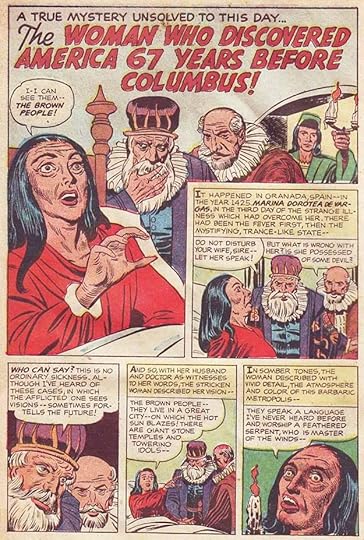 From BLACK CAT (MYSTIC) #60, Nov 1957, Harvey
From BLACK CAT (MYSTIC) #60, Nov 1957, HarveyIn some of Howard’s final stories, he was returning to creative extras in a small way, like the bold and larger initial capitals in some of these captions. His THE in the story title is very familiar.
HARVEY (Part 3)
ALARMING TALES
#1 Sept 1957: Table of Contents 1pp, The Cadmus Seed 5pp, Logan’s Next Life 2pp, The Fourth Dimension is a Many Splattered Thing 5pp, Last Enemy 6pp, Donnegan’s Daffy Chair 4pp
#2 Nov 1957: Table of Contents 1pp, Hole in the Wall 6pp, Big Hunt 4pp, Fireballs 5pp, I Want to Be a Man 5pp
#3 Jan 1958: This World is Ours 5pp
#4 March 1958: Forbidden Journey 5pp
BLACK CAT (MYSTIC)
#58 July-Sept 1956: Mr. Zimmer (2 stories) 1pp, 5pp, Mysteryvision 5pp, Jim Bowie House Ad 1pp, Gismo 5pp, Help 5pp
#59 Sept 1957: Table of Contents 1pp, Today I Am A–? 5pp, A Weemer is the Best of All 5pp, The Great Stone Face 5pp
#60 Nov 1957: Table of Contents 1pp, A Snap of the Fingers 5pp, The Woman Who Discovered America 67 Years Before Columbus 2pp, A Town Full of Babies 5pp, The Ant Extract 5pp, Shadow Brother 5pp
If my math is right, I count 6,043 pages in all. For this index, I’ve only credited Ferguson on stories where I could find and check scans of the pages. There are a few credited on the Grand Comics Database that I couldn’t find, like Western Tales 32 and 33 at Harvey (1956). If they turn up and have Howard’s work, I’ll add them. And I’m sure there are some I missed. Thanks to Harry Mendryk at the Kirby Museum site for his pioneering work on identifying Ferguson lettering for Simon and Kirby.
The post HOWARD FERGUSON – SIMON & KIRBY LETTERER Part 2 appeared first on Todd's Blog.
April 11, 2023
HOWARD FERGUSON – SIMON & KIRBY LETTERER Part 1
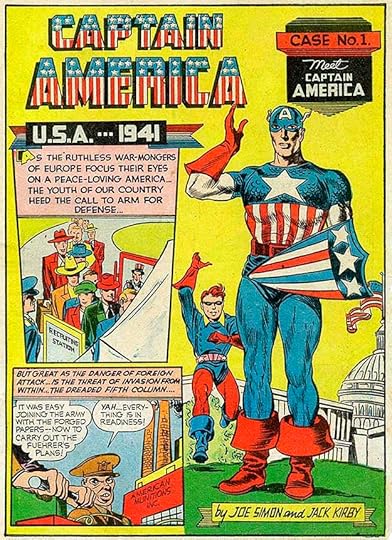 From CAPTAIN AMERICA COMICS #1, March 1941, image © Marvel
, image courtesy of Michael J. Vassallo’s BLOG
From CAPTAIN AMERICA COMICS #1, March 1941, image © Marvel
, image courtesy of Michael J. Vassallo’s BLOGIn the early days of comics, lettering was often done by the artist himself, but in a few cases success meant an artist or studio could hire someone just to do the lettering. That was the true for the studio of Joe Simon and Jack Kirby, which began in 1940, doing work for Fox Publications and then Timely/Marvel Comics, among others. In his 2011 autobiography, Joe Simon, My Life In Comics (Titan Books, 2011), Simon puts the date at 1939, but elsewhere he says he began working at Fox in December 1939, where he met Kirby, so 1940 seems more likely. Joe wrote that as they gained clients they hired Charles Nicholas to work for them as a penciler, inker and scripter, and soon “…we brought in a letterer, too. The letterer’s name was Howard Ferguson, and he was the best ever in the business.” Howard is probably known today (if at all) as the letterer of most of the original ten issues of CAPTAIN AMERICA COMICS, as seen above. Howard’s balloon lettering developed and grew more confident over the first year with Simon & Kirby, but right from the start he was trying to add extra creative touches: variety in styles, special treatments for the first letter or word of a caption (as shown), special caption styles, and more. I call these things “creative extras,” and they were almost always present in his work except in the last few years. Clearly he wanted his lettering to stand out from the crowd, to be noticed and appreciated, and it certainly was by Joe Simon and Jack Kirby.
This article is in two parts. In Part 1 I’ll outline Howard’s entire life and career, with the help of research done by Alex Jay and myself and information from his granddaughter, who I recently contacted online. Part 2 will focus on his lettering work in detail, and include as complete a list of it as I can manage.
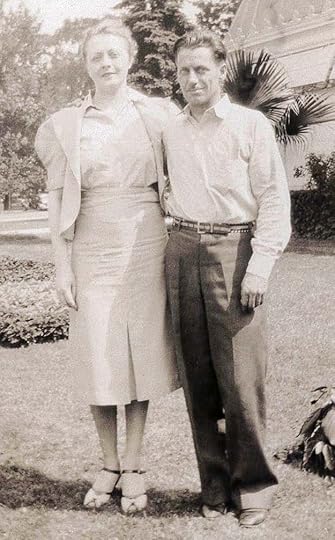 Edith and Howard Ferguson, probably late 1930s, courtesy of Patty Thomas.
Edith and Howard Ferguson, probably late 1930s, courtesy of Patty Thomas.A rare photo of Howard, with his third wife, Edith. It’s undated, but late 1930s seems likely. The palm trees suggest a Florida vacation or honeymoon. Patty Thomas and her siblings never knew their grandfather, he died well before they were born, as did their grandmother. Patty told me that their daughter, her mother Elsie, never spoke about Howard or his family, but Patty did remember a few helpful things that I’ve added to his story, and she found a few photos like this one.
Howard Grant Ferguson was born July 4, 1895 in Washburn, Wisconsin, according to his draft cards (his Social Security application has 1896) to Grant and Minnie (Marion) Ferguson. Both Howard’s father and his mother’s father, were railway clerks, and lived at the same address in Superior, Wisconsin in 1899. For more details on Howard’s early family life, see Alex Jay’s article HERE. At some point, Howard’s parents divorced, and his father moved to Duluth, MN. Howard and his mother lived with his maternal grandmother Elsie in Superior in the 1905 Wisconsin state census. By 1907, Minnie had married Arba Hawley, and they also were in Duluth. In the 1910 census, when Howard was about 15, he, his mother and step-father, maternal grandmother, and three-year-old step-brother were all at the same address in Duluth, 131 West 3rd Street.
Howard graduated from eighth grade at the East End School in 1910, and was a freshman at Duluth Central High School in 1911. That year his family moved to Detroit, MI, where they would live for many years. In the 1914 Detroit city directory, Howard is listed as a student, so he probably graduated from high school there, but by 1916 he was working as a stock clerk in Detroit. That year, at age 21, he married Ida Trombley on December 26.
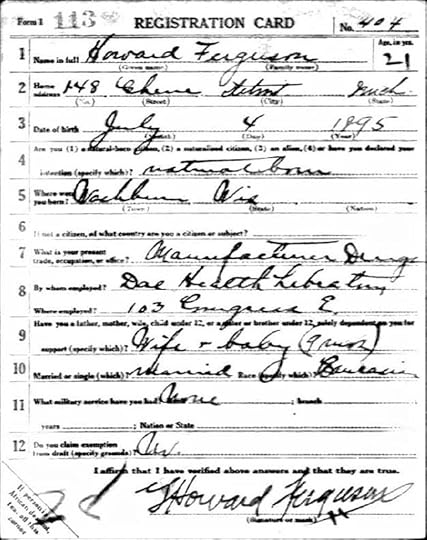 Ferguson’s World War One draft card dated June 5, 1918
Ferguson’s World War One draft card dated June 5, 1918Howard’s draft card (it’s unlikely he was called up to serve) shows he and his wife Ida and nine-month-old daughter Virginia living at 148 Chene Street, Detroit. His employer was Dae Health Laboratory, a drug manufacturer of products like Nuxated Iron with questionable health benefits. The back of the card described Howard as short, with slender build, blue eyes and light-colored hair. The 1918 Detroit city directory said he was a shipping clerk. In the 1920 census, he was a telephone company clerk. Up to this time there’s no evidence of Howard being interested in an art career, but in the 1921 city directory, he’s listed as an artist. Perhaps he studied showcard lettering from books, or took a course somewhere. By 1923, he was working for the S.M. Epstein Company, which specialized in jewelry advertising. In 1925 he worked as an artist for the Detroit Ad-Service. He may have worked on print ads and/or store signs for these companies, and his home address changed several times, suggesting he was struggling.
Ferguson’s family life changed in 1927. Divorce from Ida was finalized on April 8, 1927 in Detroit. The cause was “extreme cruelty,” and alimony was granted. His daughter Virginia was nine years old. Eight days later, on April 16, Howard married his second wife, Marjorie V. Crawford, a twenty-year-old from France. This marriage probably didn’t last more than a few years. Meanwhile, his future third wife, Lillian Edith Stanton, married her first husband, Henry Smith Lockwood, on June 27, 1930, in Queens, New York. Again, that marriage must not have lasted long. The 1940 census shows that both Edith (as she was known) and Howard were living in Detroit in 1935, and they must have met there and married some time before 1940. The census has them living with Edith’s parents Arthur and Lillian Stanton and sister Marjorie in Jamaica, Queens, New York at 173-43 103rd Road. Howard’s occupation was “artist doing private work,” in other words, a freelancer. With his advertising background, he was probably getting similar work in Manhattan, and he found more with the newly formed Simon and Kirby studio in 1940. He was about 45 years old, much older than his new employers.
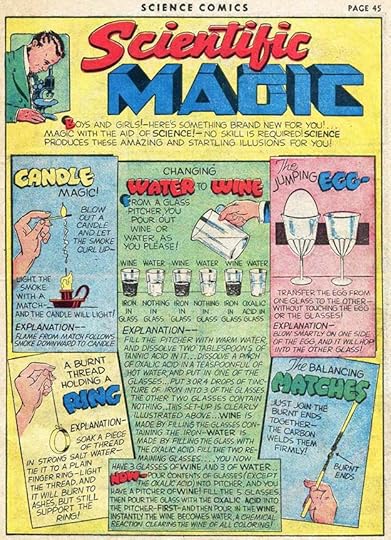 From SCIENCE COMICS #7, Aug 1940, Fox Publications
From SCIENCE COMICS #7, Aug 1940, Fox PublicationsJoe (originally Hymie) Simon was born Oct 11, 1913 in Rochester, NY to poor parents, his father was a tailor. He showed early artistic talent, and did art for his high school newspaper and yearbook. After graduation, he worked at newspapers in Rochester and Syracuse, and in 1937, moved to Manhattan looking for work as an artist. He got into comics in 1939, first by working at Funnies, Inc., Lloyd Jacquet’s studio, which packaged comics for publishers who did not produce their own stories, or enough of them. His first story, a six-page western, appeared in AMAZING-MAN COMICS #10 from Centaur dated March 1940. Keep in mind that comic books were always dated about two months later than when they actually went on sale, and often were being created two or three months before that at least, so Simon’s first story might have been drawn in the summer or fall of 1939. In December, 1939, Simon answered an ad for artists at Fox Publications, and not only landed comics work, he was hired as an editor, though never so credited in the books. That would happen a lot, Joe must have come across as knowing what he was doing in comics, even from the start.
Another artist working for Fox was Jacob Kurtzberg (later known as Jack Kirby), born Aug 28, 1917 on the Lower East Side of Manhattan, also to a poor family whose father was a tailor. Jack loved to draw and knew he wanted to make a living at it. He was entirely self-taught, studying the newspaper strips he liked, and in 1936 he began working on strips for a small syndicate. He also found work at the Will Eisner and Jerry Iger packaging studio, and by late 1939, he’d taken a staff job with Fox. Joe was impressed with his work when they met there, and especially his drawing speed, and when Jack heard Joe was also doing other comics work on the side, he asked if he could join him. The Simon and Kirby studio was born. Simon rented a small office near the mid-town Manhattan publishers they were working for, and when he and Kirby went there after work hours at Fox, they began turning out new material to sell to other publishers, or to order. Their work was soon in demand, and they never looked back. Both Joe and Jack could do everything, but each had strengths: Joe was good at logos, covers, and splash pages, and was the better businessman and salesman. Jack was a fast penciller who loved to draw and he was full of ideas for characters and stories. Both did some writing, inked pages, and lettered. Soon they could afford to hire more help, which is when Charles Nicholas and Howard Ferguson were hired, the first of many Simon and Kirby assistants.
It’s not known if Howard had any prior comics experience, but everyone in comics at the time was new, and they were all figuring it out as they went along. An early page by Ferguson, above, is one of several one-page magic trick fillers created for Fox. I think Howard did the art as well as the lettering. Perhaps he had an interest in magic tricks, and wrote it as well, but that’s a guess. Ferguson was working for Simon and Kirby, but these might have been done directly for Fox, where the editor and buyer was Joe Simon. The page was probably done in early 1940.
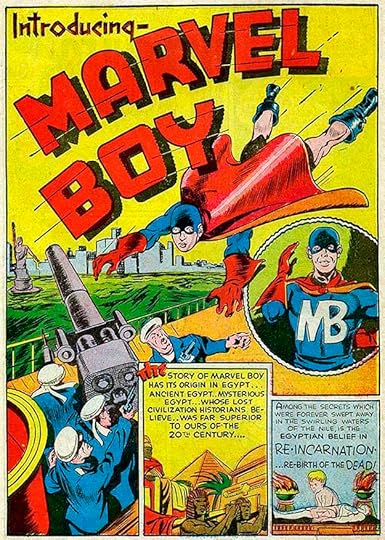 From DARING MYSTERY COMICS #6, Sept 1940, © Marvel, image courtesy of Michael J. Vassallo’s BLOG
From DARING MYSTERY COMICS #6, Sept 1940, © Marvel, image courtesy of Michael J. Vassallo’s BLOGSimon, Kirby, and Ferguson did a lot at Fox, but were also freelancing to other publishers like Timely, now known as Marvel Comics. The page above has art by Joe Simon and early lettering by Ferguson, who I think also did the feature logo, perhaps from Joe’s layout. Notice the open THE at the beginning of the first caption, one of Howard’s “creative extras.” His early lettering is clear and readable, but not yet in the style he would be using in a few months. I don’t know who was paying for Howard’s lettering at Fox, he might have been paid directly there, but on other freelance work, he might have been paid by Simon & Kirby out of their fee.
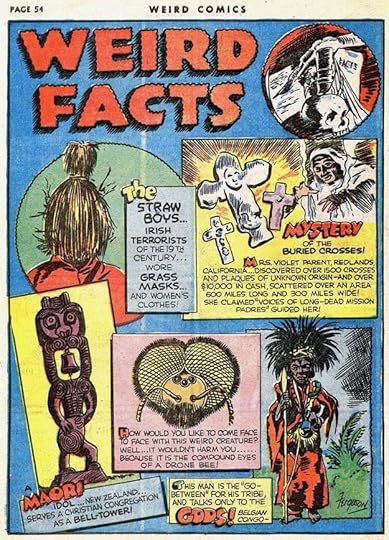 From WEIRD COMICS #7, Oct 1940, Fox Publications
From WEIRD COMICS #7, Oct 1940, Fox PublicationsAnother filler page, and this one is signed by Ferguson at lower right, a sure sign he also did the art. This page has lots of creative extras: a creepy title, large open letters in the captions, and smaller ones at the beginning of the text in some. The feature mimics “Ripley’s Believe It Or Not,” and the art is well done in that style. Howard had found a home for his art and lettering, though he was mainly lettering. In his book, Joe Simon said of Ferguson: “Howard was a chain smoker who drank coffee all day. When we got his pages, there were always coffee stains and cigarette burns on them. But he was unlike any other letterer in the business. Nobody could do the work that Howard Ferguson did.”
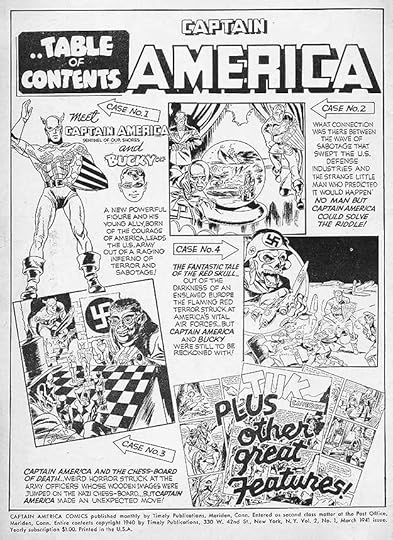 From CAPTAIN AMERICA COMICS #1, March 1941, © Marvel
From CAPTAIN AMERICA COMICS #1, March 1941, © MarvelAfter about three months as editor for Fox, publisher Victor Fox found out about Joe and Jack working for other companies, and they were out. In their own studio they worked on features like BLUE BOLT for Novelty/Curtis, and stockpiled new stories of their own in hopes of selling them. World War Two had begun in Europe, and that’s when the idea for Captain America was born. Joe and Jack felt a hero was needed who could punch Hitler. Joe reports that they produced an entire issue’s worth of stories. Then Timely/Marvel’s publisher Martin Goodman called Simon into his office some time in 1940. Goodman had decided he was too dependent on shops like Funnies, Inc., and wanted to hire his own staff and freelancers to produce comics stories. He offered Simon and Kirby a better page rate to work for him directly. It was freelance at first, but soon Simon showed him the Captain America stories, and Goodman loved them. So much so that he decided to publish Cap in his own title right away, instead of the usual process of adding him to an anthology. CAPTAIN AMERICA COMICS was a hit, and full of Howard Ferguson work. Above is the contents page he lettered, showcasing the variety of styles and creativity he brought to the project.
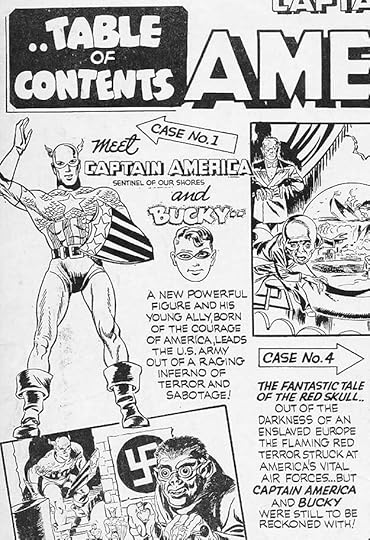 From CAPTAIN AMERICA COMICS #1, March 1941, © Marvel
From CAPTAIN AMERICA COMICS #1, March 1941, © MarvelHoward’s regular lettering had also changed by this time, he was now using a wedge-tipped pen that gave each letter more variety of widths, depending on which direction the strokes were going. He might have picked up this idea from Frank Engli’s lettering on the newspaper strip “Terry and the Pirates,” a popular one at the time, though Ferguson kept his letters more rounded than Engli. The result was appealing. Howard’s regular letters tend to lean to the left a bit sometimes, as here. Martin Goodman was so happy with the book, he hired Joe Simon as Marvel’s first editor, and Jack also came in as art director. Martin Goodman’s teenage nephew, Stanley Leiber (Stan Lee), was Joe’s office boy and assistant. Howard was soon getting all the lettering work he could handle on a variety of Marvel titles, but he continued to do some work at Fox for a while. In Comics Interview #7, Jan 1984, David Anthony Kraft interviewed veteran letter Joe Rosen about getting his start in comics. Joe said:
My father had a fruit store in Coney Island. In 1940, one of the customers he was well acquainted with mentioned that her son was an artist for Timely—the company that’s now Marvel Comics. The son, George Mandel, is now a novelist. This was during the Depression. My father asked her if her son could maybe do something for Sam. So Mandel introduced Sam to the big letterer of the time, Howard Ferguson, who was working for both Timely and Fox. Fox was Ferguson’s lesser account, and soon he gave it to Sam. Sam got me my first lettering job, at Fox, doing THE BLUE BEETLE.
This was generous of Howard, but of course, the work assignments were not his to give. What he could do was coach Sam Rosen to sharpen his lettering skills, and bring him to Fox as a suggested replacement. I see Ferguson lettering at Fox through issues published in the first half of 1941, and one as late as Sept 1941, but remember the lead time and post-dating. Howard’s last work for Fox may have been in early 1941. Soon after, very similar but somewhat different lettering began appearing, probably by Sam Rosen.
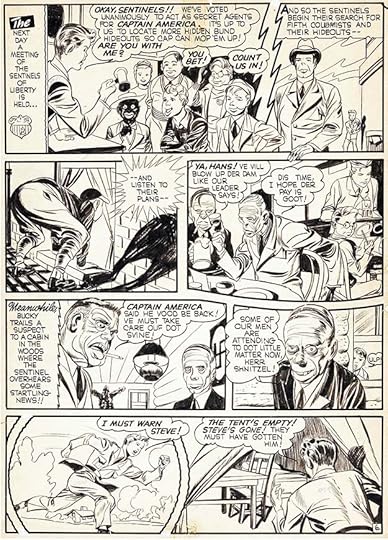 From CAPTAIN AMERICA COMICS #5, Aug 1941, image © Marvel, original art courtesy of Heritage Auctions
From CAPTAIN AMERICA COMICS #5, Aug 1941, image © Marvel, original art courtesy of Heritage AuctionsI’ve found a scan of only one page of original art from that original Captain America run by Simon, Kirby, and Ferguson. I wonder if that’s a Ferguson coffee stain at the top center? Surprisingly, Howard did very little lettering on issue #2, and none on #3. My guess is that Simon and Kirby were scrambling to get up to speed with a volume of work they weren’t expecting. Comics were longer then, and each issue had about 50 pages of Cap stories, and a few other features too. They hired more help to get everything done on time, including the lettering. By issue #4, about half the lettering is by Ferguson, and he did all the Cap stories in issues 5 to 10. How many of Howard’s creative extras can you find on this page?
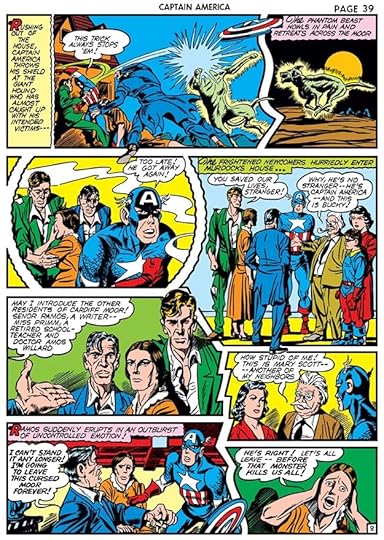 From CAPTAIN AMERICA COMICS #10, Jan 1942, image © Marvel
From CAPTAIN AMERICA COMICS #10, Jan 1942, image © MarvelOn this later Captain America page, all the regular lettering is slanted to the right, but still has Howard’s creative extras. For a while, Simon and Kirby gave up their own office and did all their work at Timely. Howard may have lettered there, or at home, probably both. Simon and Kirby had signed a lucrative deal that was supposed to include a share of the profits. CAPTAIN AMERICA COMICS #1 sold nearly a million copies, and should have generated lots of profit for everyone, but when royalties were paid, Joe and Jack got almost nothing, due to creative accounting by Goodman that subtracted the entire cost of running Timely from the book. Simon was disgusted, and he and Kirby secretly went to National/DC Comics in search of a better deal. They found one.
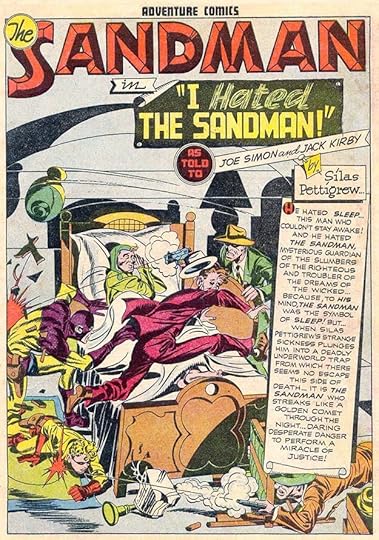 From ADVENTURE COMICS #87, Aug 1943, image © DC Comics
From ADVENTURE COMICS #87, Aug 1943, image © DC ComicsDC offered Simon and Kirby a sweet arrangement, more than twice what they were making at Marvel. They continued to work at Marvel for a short time, but when management there heard of the deal, they were fired. Howard may have continued to letter at Marvel for a short time, but Simon and Kirby moved on to DC, where at first they tried to come up with new features, but nothing was working, so they agreed to revamp two existing DC properties in their own style, Manhunter and Sandman, each appearing in ADVENTURE COMICS. The Simon and Kirby versions began in issue #72 dated March 1942, and were therefore probably produced in the fall of 1941. Joe and Jack opened a new studio in Tudor City, a large apartment complex on East 42nd Street, Manhattan favored by comics artists.
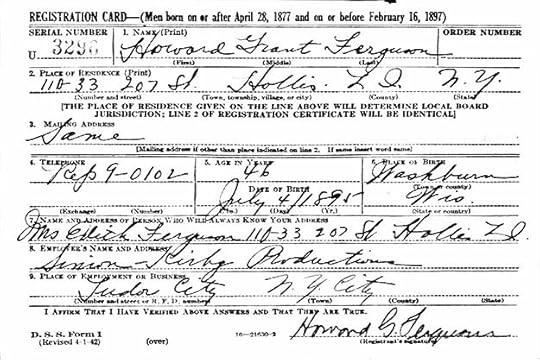
Surprisingly, Howard Ferguson did not letter the earliest DC stories. Perhaps he took some time off. His wife Edith gave birth to their daughter Elsie on January 5, 1942, that would have been a good reason! Elsie remembered that she was born in the home of her grandparents, the Stantons. On his World War Two draft card, dated April 27, 1942, we see Howard and his family living at 110-33 207th Street, Hollis, Long Island, New York, a small single family home built in 1930, and now in Jamaica, Queens. The money he was making in comics had allowed Howard and Edith to afford their own place, though they were probably renting it. Mrs. Edith Ferguson is listed as the person who would always know his address. Howard’s employer is Simon-Kirby Productions in Tudor City. In his book, Joe Simon said Howard’s daughter Elsie “was his pride and joy.”
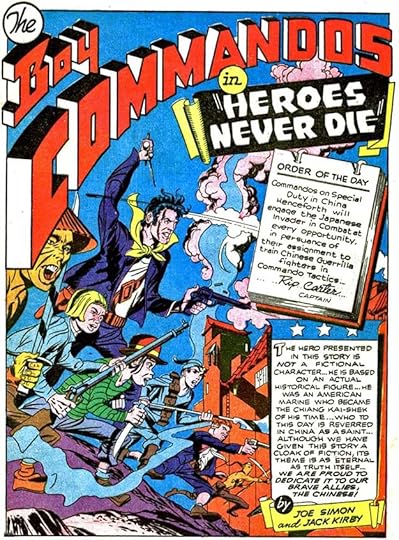 From BOY COMMANDOS #1, Dec 1942, image © DC Comics
From BOY COMMANDOS #1, Dec 1942, image © DC ComicsWith the success of Sandman and Manhunter, Simon and Kirby added new features they created, Boy Commandos and The Newsboy Legion, each appearing in existing DC anthologies, and the former soon getting its own popular title that reportedly outsold SUPERMAN at first. Beginning with stories appearing in comics dated Aug 1942, Howard Ferguson was lettering nearly all of them again, two fine examples are above. The Sandman logo predates Simon and Kirby, but Ferguson did everything else on these exciting splash pages. Simon and Kirby were now a franchise, and Howard’s lettering was an important component of their style. But America had now entered World War Two, and DC was afraid their popular new team would be enlisted out of the comics business. They urged Joe and Jack to stockpile as many stories as they could in case that happened. Howard turned either 46 or 47 in 1942, so despite his draft card, he was considered too old to serve.
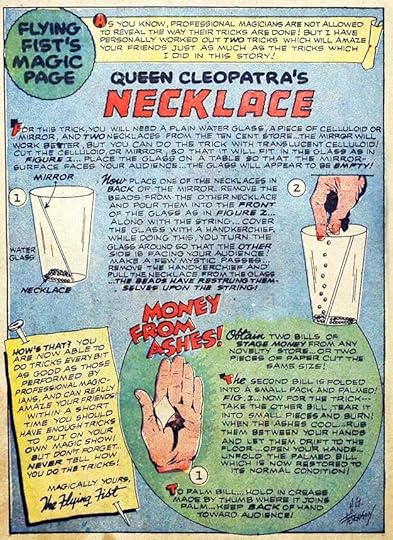
In 1943, Joe Simon enlisted in the Coast Guard, hoping it would keep him closer to home. It did, but he was stationed in New Jersey and then Washington, DC, so had little time for comics. Jack Kirby was drafted into the army, and in 1944 was on Normandy Beach under General Patton, seeing the war close up. After finishing the lettering on stories that Simon and Kirby had stockpiled, Howard was not offered further work at DC as far as I can tell, but found some at a smaller company, Crestwood/Prize, where his lettering appeared in PRIZE COMICS from late 1943 to early 1946. He even did some magic one-pagers, as above, which leads me to think this was a personal interest, and perhaps written by him too. Howard’s signature is at lower right, and his creative extras are present. Most of the Prize features were pale imitations of those from other companies, but it paid the bills. When Joe and Jack got back to New York, their DC contracts had expired. Jack took some individual freelance work at DC, but the company was no longer interested in package deals from studios. Their editors had grown used to the extra control of hiring their own freelancers individually. Simon helped Kirby at times, but was looking for a new deal elsewhere.
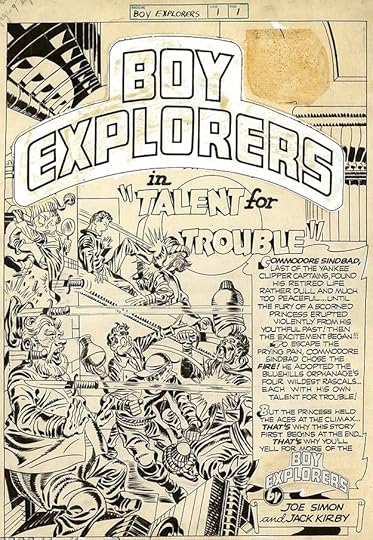 From BOY EXPLORERS #1, May 1946, original art courtesy of Heritage Auctions
From BOY EXPLORERS #1, May 1946, original art courtesy of Heritage AuctionsAlfred Harvey of Harvey Comics had befriended Joe and Jack when they all worked at Fox, and he offered Simon and Kirby that deal. They put out two new titles, STUNTMAN and BOY EXPLORERS, with fine lettering by Howard Ferguson, example above.
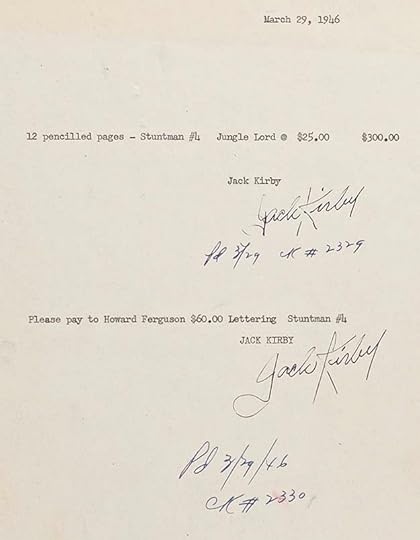 Courtesy of Heritage Auctions
Courtesy of Heritage AuctionsAlex Jay found this document showing Howard’s page rate was $5, quite high at the time for lettering I think, and reflecting his years of valued work for Simon and Kirby. By comparison, when Gaspar Saladino started at DC Comics in 1949, he was making $2 a page, and considered it a good income. Unfortunately, these books didn’t sell well, and lasted only a few issues each, with unused material appearing in other Harvey titles later. Simon and Kirby moved on to other small publishers like Hillman, and for Crestwood/Prize they did then-popular crime comics. Howard Ferguson’s work appeared there in HEADLINE COMICS. Then his lettering stopped, and Simon and Kirby hired a new studio letterer, Ben Oda, who was soon lettering all their stories, and became one of the most prolific letterers in the business over the next few decades. What happened? Here’s what Joe Simon remembered in his book:
Howard Ferguson had been our letterer back in our first stint at Crestwood when we were doing “The Black Owl.” But around the time we were working on STUNTMAN and BOY EXPLORERS for Harvey Comics, or soon thereafter, Howard passed away. Given all of the coffee and cigarettes he had consumed, I suppose we weren’t really surprised. While Jack and I were getting re-started at Crestwood, we found Howard’s successor, the second-best letterer in comics, Ben Oda.
Memory is a tricky thing, and Joe’s book was written more than fifty years after the events described. Someone did die in 1946, but it wasn’t Howard, it was his wife Edith. Howard’s granddaughter Patty Thomas said her mother Elsie told her that Edith died when she was four. Patty also had a funeral notice from a newspaper with the date, Jan 29, 1946. Elsie had turned four a few weeks earlier. Alex Jay found Edith’s death certificate. She had been diagnosed with tuberculosis in Nov 1945, and admitted to Triboro Hospital, Jamaica, Queens, on Jan 15, where she died at age 34. What a devastating blow to both Howard and Elsie. Patty said the loss was very hard on her mother. While grieving, Howard also had to take care of a child who was not yet old enough for school. He and Elsie were again living with Edith’s parents and sister, and I’m sure they helped, but some time in 1946, Howard decided to return with Elsie to his own family in Detroit. Late in life, Elsie put together a scrapbook about her childhood. She wrote, “After my mother passed away in January, 1946, my father and I went to live with Grandma Hawley in Detroit, MI. We lived there for only two years. When Grandma passed away, we moved back to Queens Village, NY with Grandma and Grandpa Stanton and Aunt Marge…my mother’s parents and sister.” Marion (Minnie) Hawley died on Dec 20, 1947, so it’s likely that Howard and Elsie were back in Queens by mid-1948.
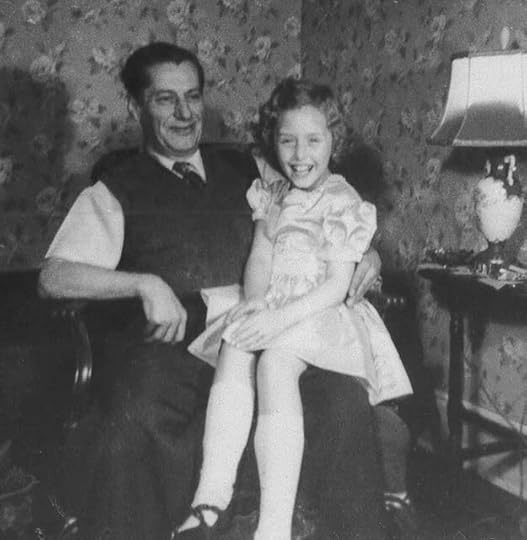 Undated photo of Howard and Elsie, courtesy of Patty Thomas
Undated photo of Howard and Elsie, courtesy of Patty ThomasI would guess Elsie is about 7 here, so perhaps it was taken about 1949. This is also from the scrapbook Elsie put together late in her own life, and of the few photos of Howard in it, I like this one the best. He looks happy with his daughter, his favorite person, and she looks equally happy.
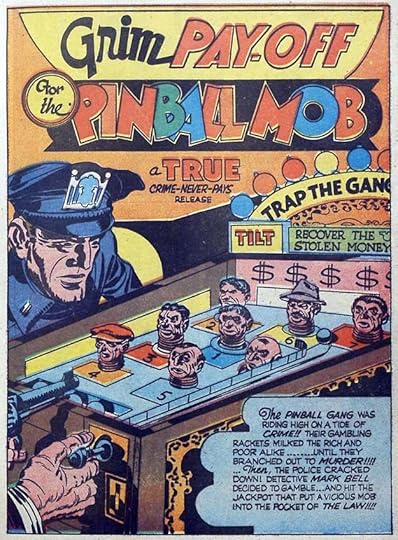 From HEADLINE COMICS #24, May 1947, Prize
From HEADLINE COMICS #24, May 1947, PrizeSo how does the move to Detroit line up with the published lettering I found by Howard? The work for Harvey on BOY EXPLORERS and STUNTMAN was probably all done before the move, though some was published later in other titles. BLACK CAT COMICS also has Danny Dixon stories in issues 4-6, the last of those dated June-July 1947, I don’t know if they were done for the cancelled titles. At Prize, Howard lettered lots of stories in HEADLINE COMICS #23-25, the last of those issues dated July-Aug 1947. At Avon, Howard lettered stories in COW PUNCHER COMICS #6-7, the latter dated May 1947, and one of those even has his lettering credit. Publishers (and artists) rarely hire letterers who must work by mail, as it adds too much time to the process, corrections must be done by someone else, and deadlines are relentless, but possibly that was tried for a while with Ferguson, at least until Simon and Kirby hired Ben Oda. Perhaps by then Howard had found work again in Detroit in advertising. It’s also possible that all the comics work lettered by Howard published with 1947 cover dates was finished before he left, and just took time to see print. Certainly the ones penciled by the very fast Jack Kirby could have been done well ahead. I’m guessing that Howard and Elsie were in Detroit from mid 1946 to mid 1948. I found no comics lettered by Ferguson that have 1948 cover dates.
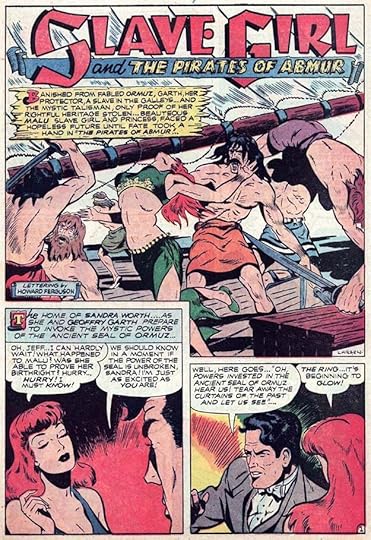 From SLAVE GIRL COMICS #2, April 1949, Avon
From SLAVE GIRL COMICS #2, April 1949, AvonWhen he returned to Queens, I’m sure Howard went to Simon and Kirby looking for lettering work, but as far as I can tell, they didn’t give him any. They must have been happy with Ben Oda, who might not have been as creative as Howard, but he was fast, and willing to work long hours or overnight to meet deadlines. Possibly Joe and Jack remembered Howard as being difficult to work with at times. Howard must have been disappointed or angry about this, but he went around to other New York publishers and picked up lettering work here and there. The story above has his lettering credit. He did work for Avon, Gilberton, Seaboard, St. John, and Stanley Morse through 1953. He might also have found work in advertising.
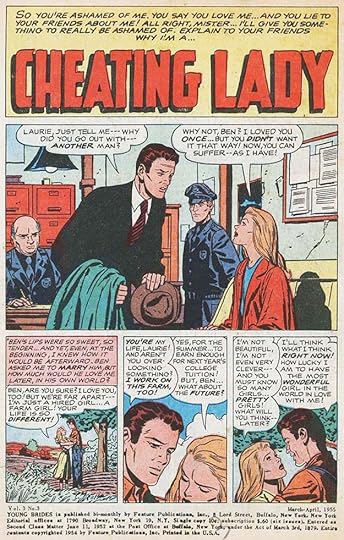 From YOUNG BRIDES #21, March 1955
From YOUNG BRIDES #21, March 1955Meanwhile, Simon and Kirby’s career went through ups and downs typical of comics. At Prize, they had great success creating a new genre: romance comics. It began with YOUNG ROMANCE in 1947, and expanded to two more titles, YOUNG BRIDES and YOUNG LOVE. Girls hadn’t had many comics aimed at them to that point, and they bought them in droves. It was a trend soon imitated by all the other comics publishers. They also put out BOYS RANCH (their favorite comic) and BLACK MAGIC, an early horror title. Nearly all the stories were lettered by Ben Oda. In 1953, Simon and Kirby were talked into starting their own comics publishing company, Mainline Comics, renting space at Harvey. They put out four titles in four popular genres: BULLSEYE: WESTERN SCOUT, FOXHOLE, IN LOVE and POLICE TRAP. All those I could find scans of were lettered by Oda. It became a financial disaster when POLICE TRAP was featured in congressional hearings on crime comics, and then their distributor, Leader News, went bankrupt. Mainline was gone by 1955. They found a home for their unpublished issues at Charlton Comics, known for their low pay rates, but Charlton at least had its own printing plant and distribution system. Howard Ferguson must have reconnected with Simon and Kirby in 1954, as he lettered some Charlie Chan stories they did at Charlton, among other things. Suddenly, Howard was back on Simon and Kirby romance stories at Prize, too, like the one above. It was a subdued Ferguson, with very few creative extras, but he always did a nice job on story titles, and his lettering, while slightly changed in style, was still easy to read and appealing. I think he was following what Ben Oda had been doing, and soon nearly all the romance stories, and also some on a new Captain America satire, FIGHTING AMERICAN, were by Howard. Ben Oda had expanded his workload to include a number of newspaper strips and other comics publishers, and perhaps he was now too busy to handle the Simon and Kirby work.
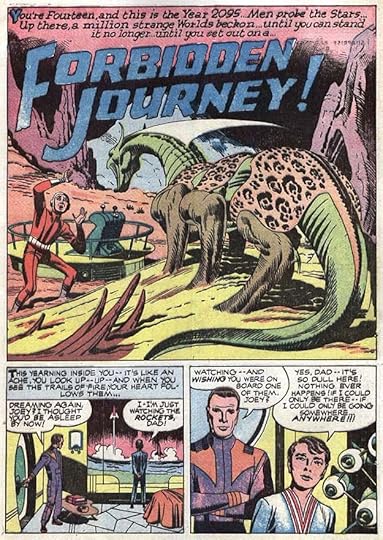 From ALARMING TALES #4, March 1958, Harvey
From ALARMING TALES #4, March 1958, HarveyFor the last few years of his life, Howard Ferguson was once more with Simon and Kirby. In a 1987 interview with Greg Theakston, published in The Jack Kirby Quarterly #10, Summer 1998, Joe Simon said: “Ferguson wanted to be with us. His problem was that he used to over-advance himself with publishers and he couldn’t go back [laughter]—you can’t go home again. But he did love to be with us. He thought we were creative.” Howard also lettered stories by them at Harvey, the last one printed is above, featuring a few creative extras, just like in his early days. Perhaps it felt like coming home.
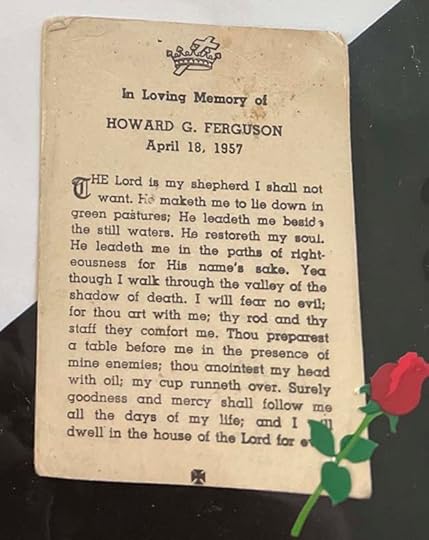 Courtesy of Patty Thomas
Courtesy of Patty ThomasHoward died on April 18, 1957 at about age 62, another difficult blow for Elsie. Alex Jay found one death record, and we have this memorial card from his funeral from Elsie’s scrapbook. We don’t know the cause of death. Elsie was fifteen, and now orphaned, but she continued to live with her mother’s family. In his book, Joe Simon said, “At the funeral, Alfred Harvey generously gave Howard’s beloved daughter Elsie a substantial check to help her out.” She married Kenneth Mott in 1961, and they had three children. Elsie lived in Queens and on Long Island, NY, then moved to the Detroit, MI area again in the 2000s. She died in 2018. I was able to find two of her children through Facebook with information Alex Jay found about her funeral. I’m sorry we couldn’t have connected with Elsie before she died, her daughter Patty thinks Elsie had no idea about the scope and quality of her father’s lettering work, and the respect it had then, and has now.
Before I leave Howard’s life story, I want to discuss some quotes about him from Joe Simon and Carmine Infantino. In his book, Joe Simon: My Life in Comics (Titan Books, 2011), Joe first mentions Howard here about hiring him in 1939 (more likely 1940):
Howard was from Detroit. His wife had left him, and he came to New York with his daughter Elsie, who was his pride and joy. She was maybe eight or nine years old at the time. Howard’s mother was an “America Firster,” one of the people who pressured the government not to get involved with World War II. The group had been organized by a Yale student. Its ranks included future President Gerald Ford and Sargent Shriver, the man who founded the Peace Corps. Howard didn’t agree with the Firsters, so he had a lot of heated arguments with his mother, and held a lifelong grudge against her.
For some time, this statement convinced Alex Jay and I that Elsie was Howard’s child with his second wife, Marjorie, but Alex couldn’t find any record of that. When I discovered Howard and Elsie living with Edith’s family in the 1950 census (released in 2022), I began to suspect Joe Simon had mixed up his memories about Elsie. When I contacted Howard’s granddaughters and show them the quote, even they wondered if there could have been two daughters named Elsie, but I think Joe just combined his memories of Howard from when he was hired with later ones when he returned to working with Simon and Kirby around 1954, when Elsie would have been about age twelve. Nothing else makes sense to me. I’ve already shown how his statement about Howard dying in 1946 was misremembered, though perhaps when Howard moved back to Detroit, he kind of died in Joe’s mind, as they had to hire a new studio letterer. As for the statements about Howard’s mother, I have no idea about those, but certainly Howard went back to live with her in 1946, so he couldn’t have held that much of a grudge. Howard may have talked about his wife leaving him (one of the first two wives), but if that statement was about Edith, he might have meant she left him by dying, and Simon misunderstood. A bit later in his book, Joe writes:
One time I brought Will Eisner in to see for himself. He came up to the studio. “Will, look at this,” I said. Howard was working on a page, and usually when you letter, you do penciled guide lines first, so your lettering can fit neatly within the lines. But Howard didn’t bother with this extra step. “Wow,” Eisner said. “I’ve never seen anybody do that before.” The lettering was straight as can be.
While this would have saved time, the ability didn’t make Ferguson’s lettering any better. It could have made it worse if his alignment went off track, but if he could do it, more power to him. I certainly never could! I’ve also heard this story about a least one other letterer, I no longer remember who.
At the 1998 San Diego Comic-Con, Joe Simon was interviewed by Mark Evanier. When asked about Ferguson, Joe said:
“Howard Ferguson was the greatest letterer and Ben Oda was the second greatest letterer. Howard Ferguson was a middle-aged man from Detroit, and like everybody else in the business he was living hand-to-mouth. He came here, he got divorced; he brought his daughter, Elsie, to live with him. I think his wife left him, he said. He was the only letterer I ever heard of that could draw in a straight line without doing the penciled lines. Just like a machine and very, very creative. He was a big part of our effort, of our creativity. He was great with logos and designs, everything. We’d just rough out the stuff and give it to Howard, and he’d give us back beautifully-inspired, inked lettering and logos. The only problem was that there’d be coffee stains on every page. (laughter) He’d drink like 30 cups of coffee a day.”
In this quote, we see some of the same errors of memory as in Joe’s book, but here he says other nice things about what Howard was able to do for Simon and Kirby. I suspect the amount of coffee Howard drank and the amount of stains continued to grow each time the story was told, as such things do.
In the book, Carmine Infantino, Penciler Publisher Provocateur (TwoMorrows, 2010), Jim Amash asked Infantino about Ferguson:
Yes! He was a crusty, old bastard. [chuckles] He was one hell of a letterer. He was a fat, older, German guy—very tough. Jack used to say, “Don’t pay attention to him. He’s all right.” He smoked cigarettes like a train. He had a daughter to take care of because his wife left him. He had a chip on his shoulder all the time, but he could letter. His logos were the best!
In the Jack Kirby Collector #34, Infantino said to Amash, “Ferguson. He was unbelievable. Great letterer. Cranky, very cranky, old guy. You say hello, he would say, ‘Go to hell….’”
These Infantino quotes are copied from Alex Jay’s article HERE.
Carmine worked with Simon and Kirby briefly at Marvel in the Captain America days, and again at Prize in the late 1940s, but these memories seem more like Ferguson in the 1950s, or simply retellings of stories from Joe Simon. Hard to know at this point. Certainly Howard had reason to be cranky in the 50s, and Carmine’s description of him as older and fat fits better with that. I found no record of Carmine working with Simon and Kirby in the 1950s when he was very busy at DC, but Infantino might have visited the Simon and Kirby studio then.
I wrote an article about Howard’s lettering for CAPTAIN AMERICA COMICS in 2011. I didn’t like his work as much then, I’ve come to appreciate it more since, especially after seeing the rest of it, which I’ll cover more thoroughly in Part 2 of this article. One thing I discussed in that first article which I haven’t here was the great house ads he did at Marvel. He also may have done some at other publishers, and designed logos for them as well. It’s harder to pin those things down, but I see suggestions of Howard’s style on logos at Avon and Seaboard, for instance, where Joe Simon was not involved. And of course he may also have been getting other freelance work in advertising in New York while working in comics. I hope these articles will bring new appreciation to the work we do know, which goes well beyond those Captain America stories, and I feel deserves to be better remembered.
Thanks again to Alex Jay and Patty Thomas for research help and images.
The post HOWARD FERGUSON – SIMON & KIRBY LETTERER Part 1 appeared first on Todd's Blog.
Todd Klein's Blog
- Todd Klein's profile
- 28 followers



